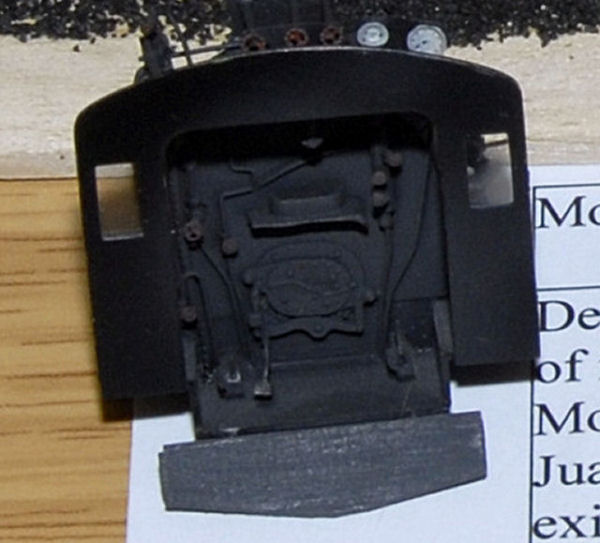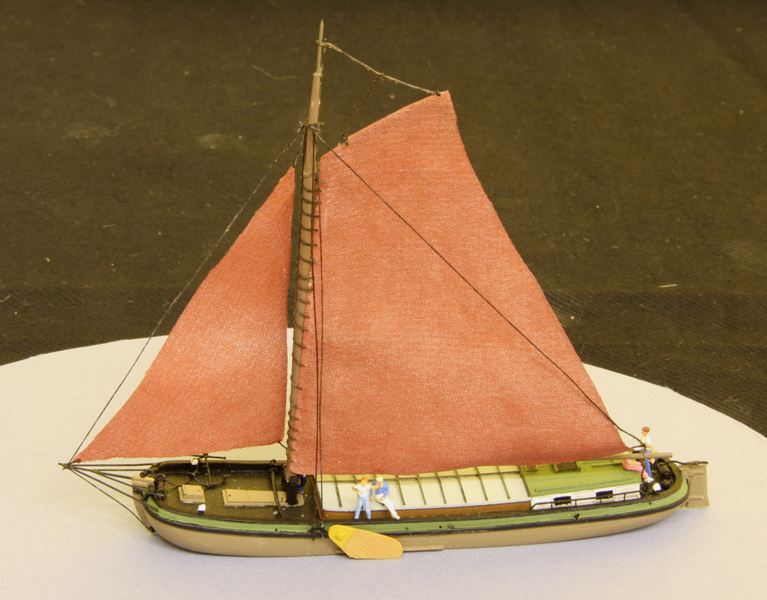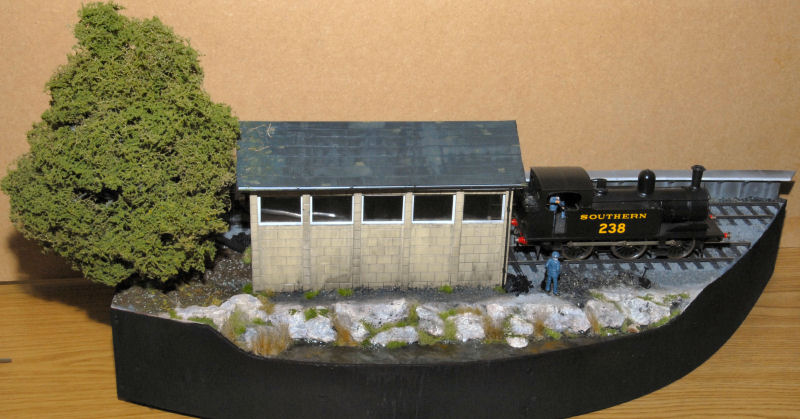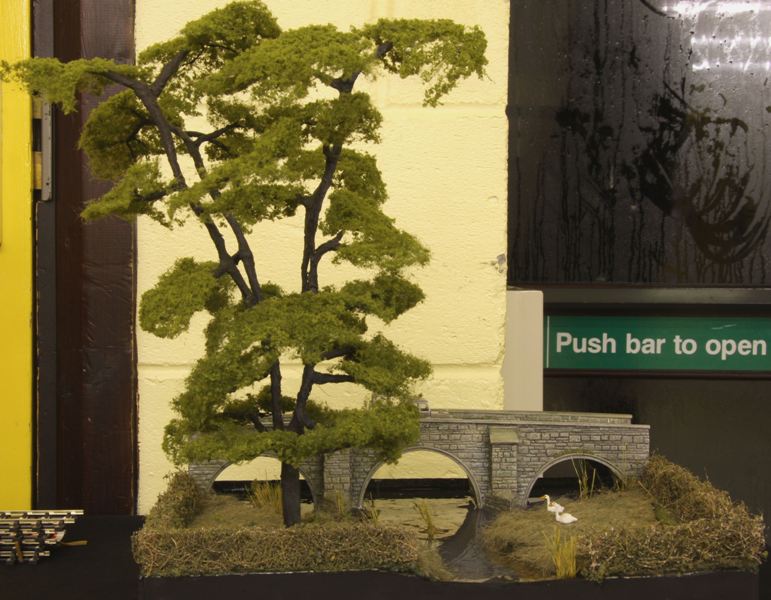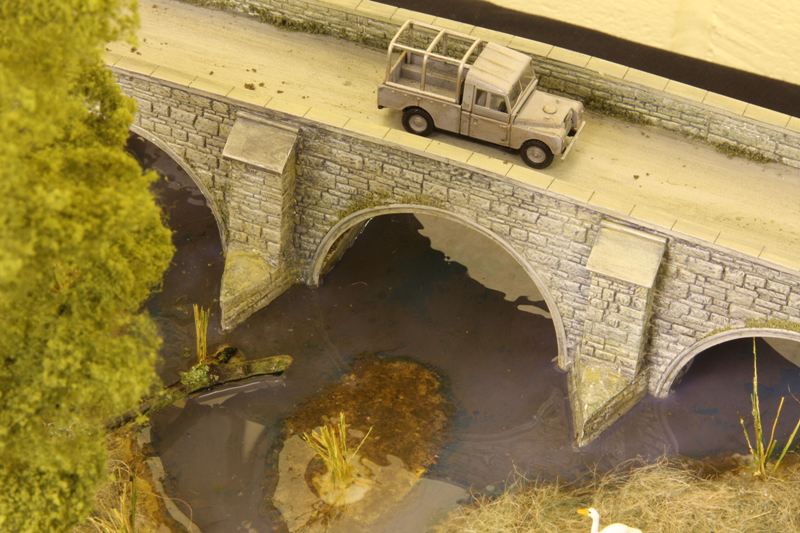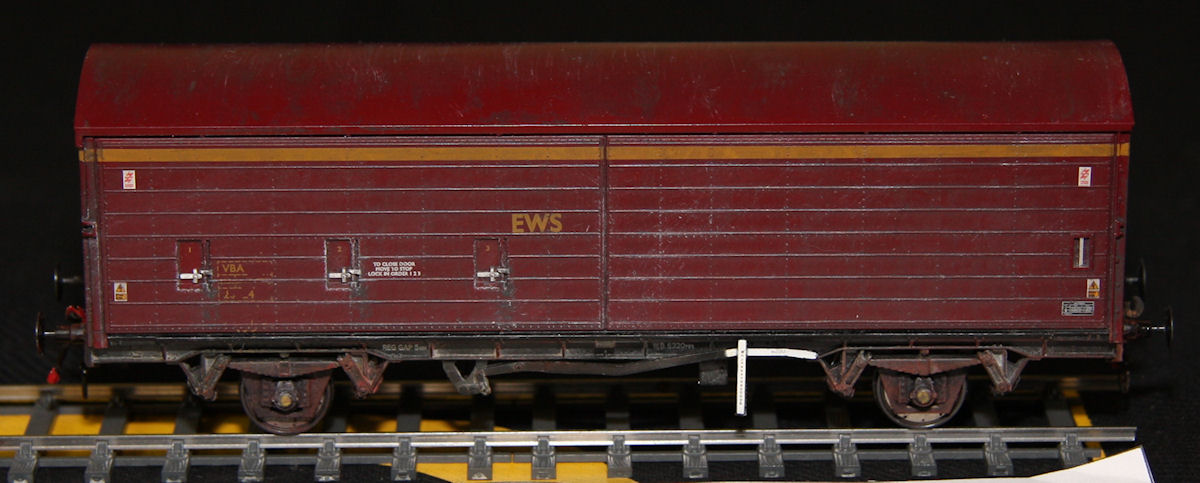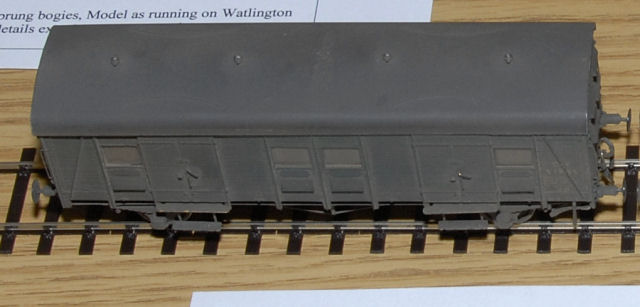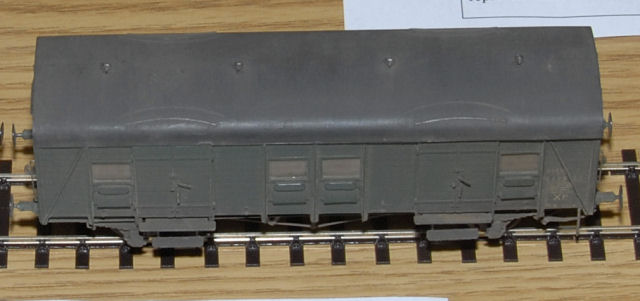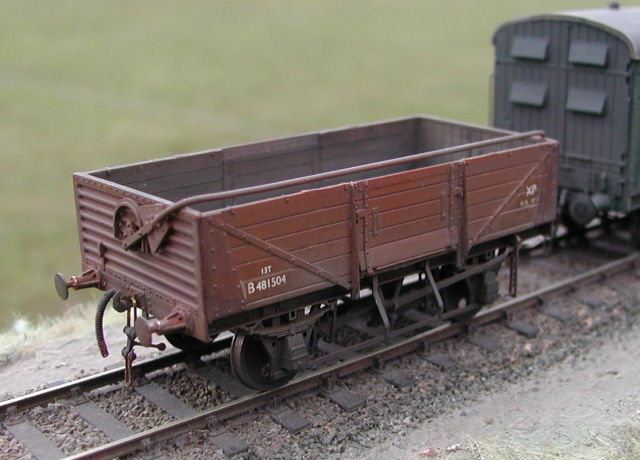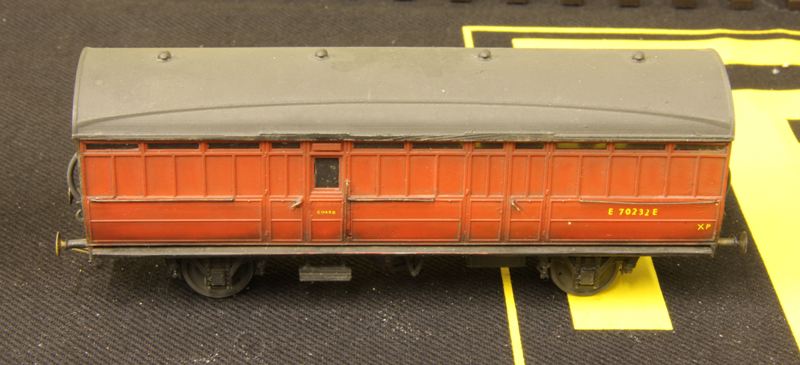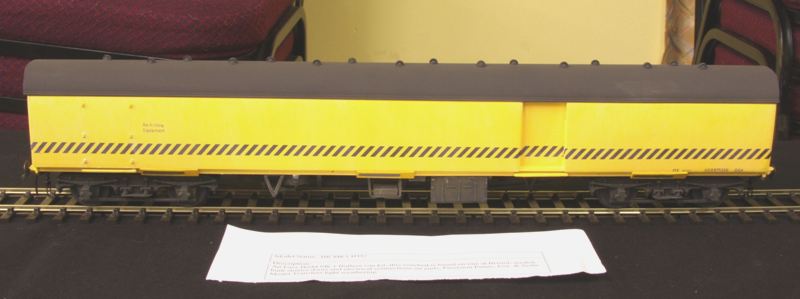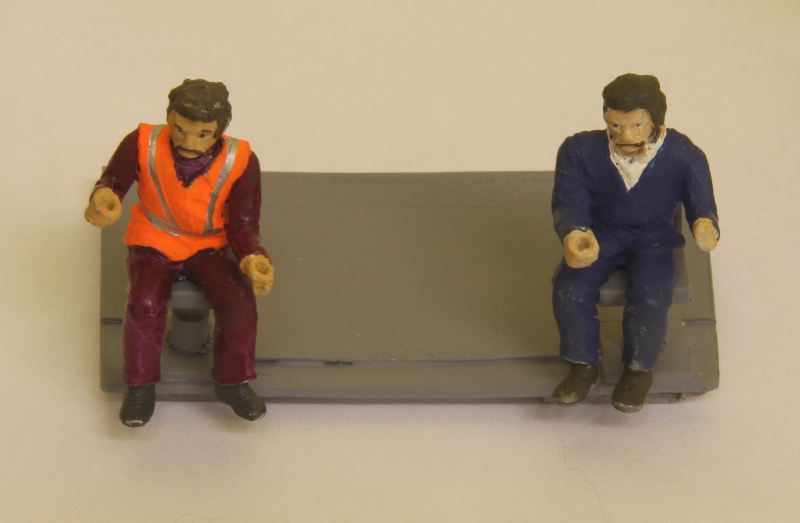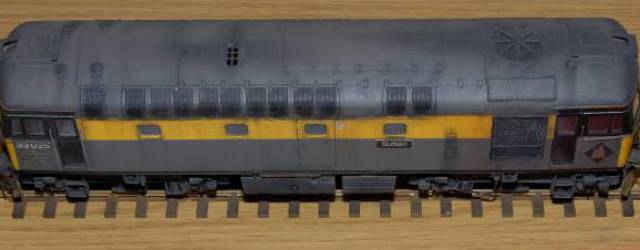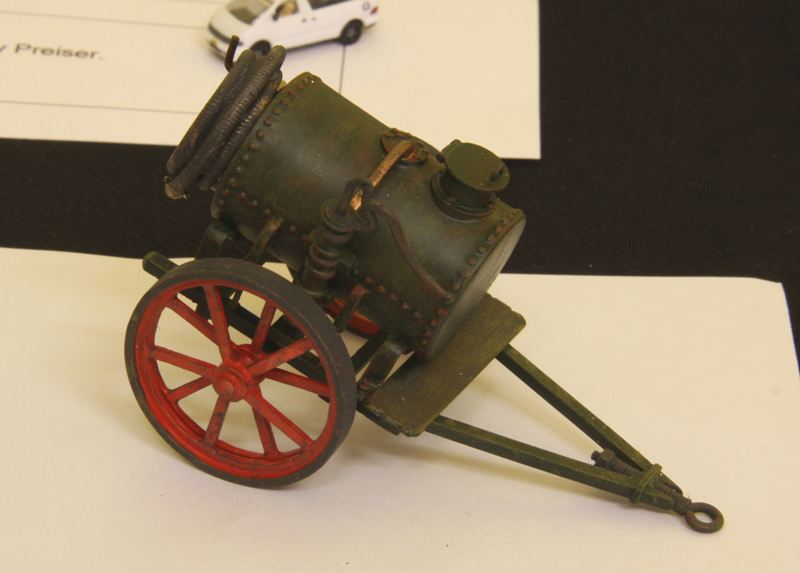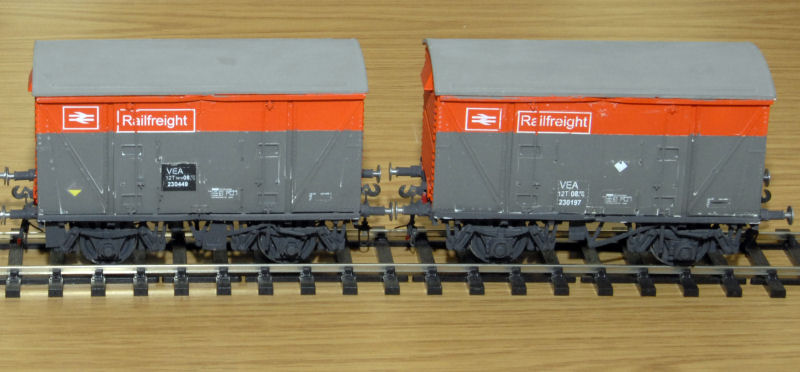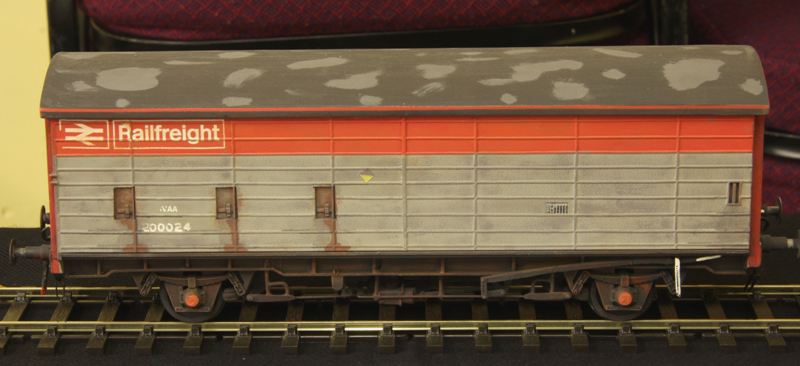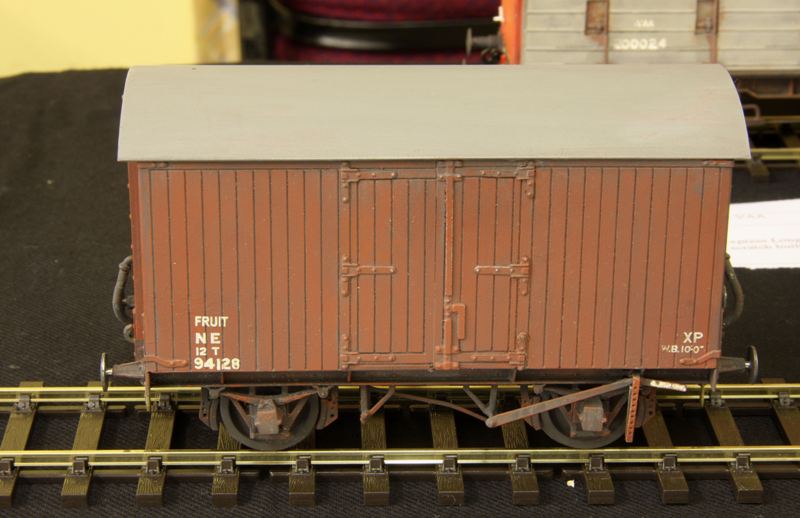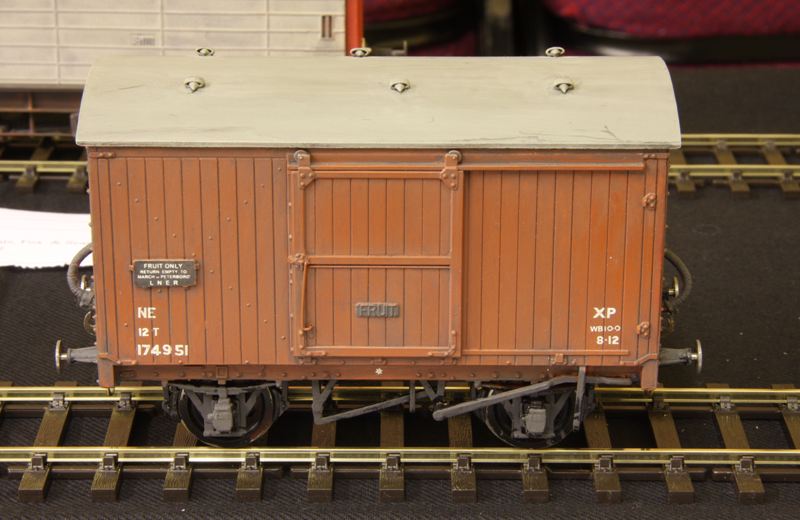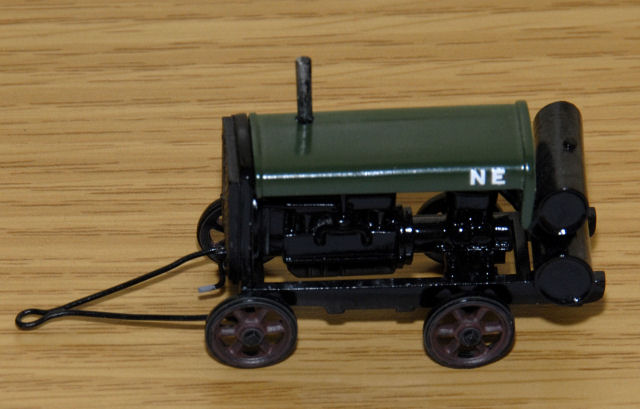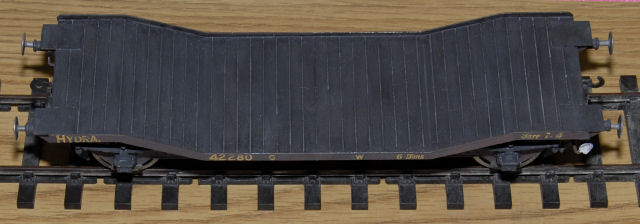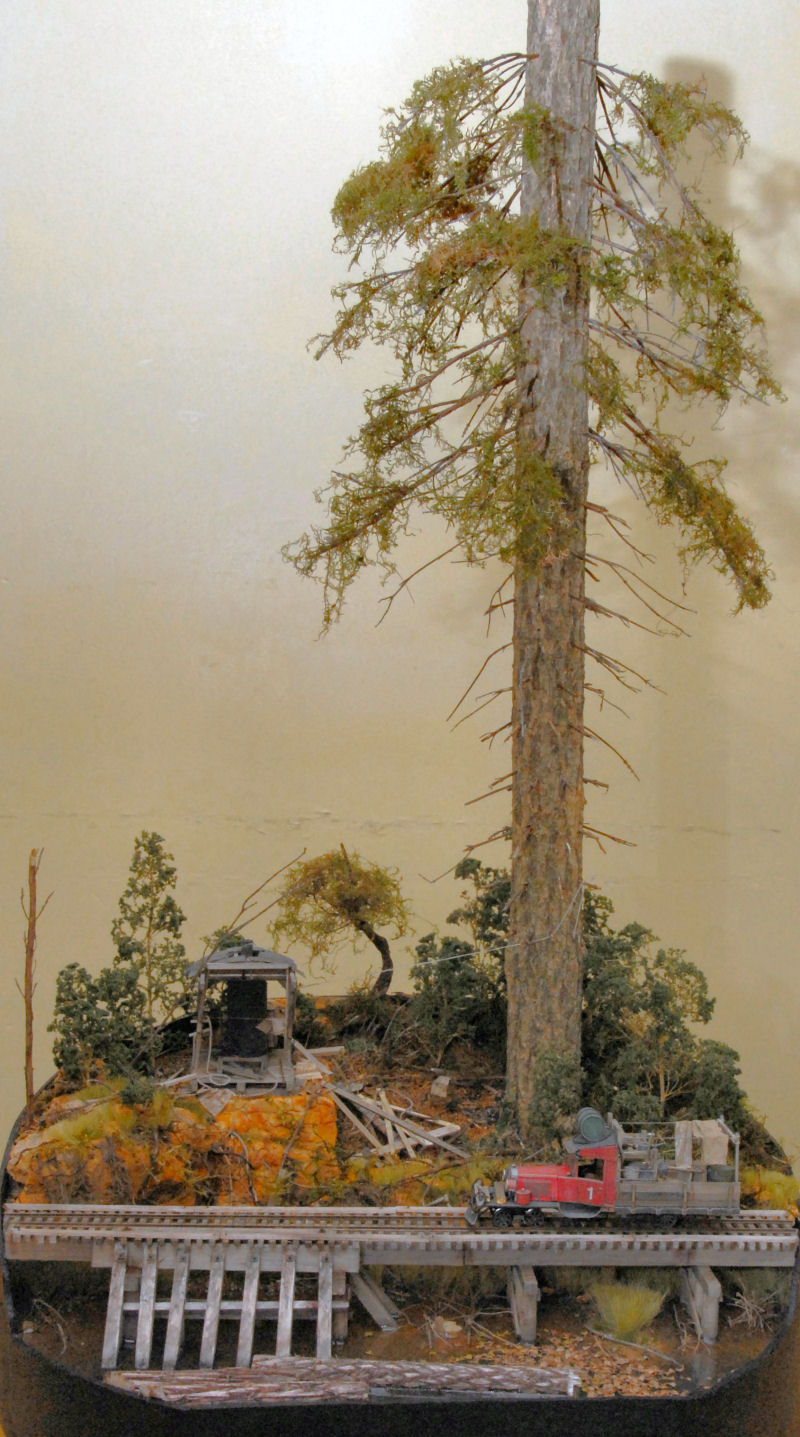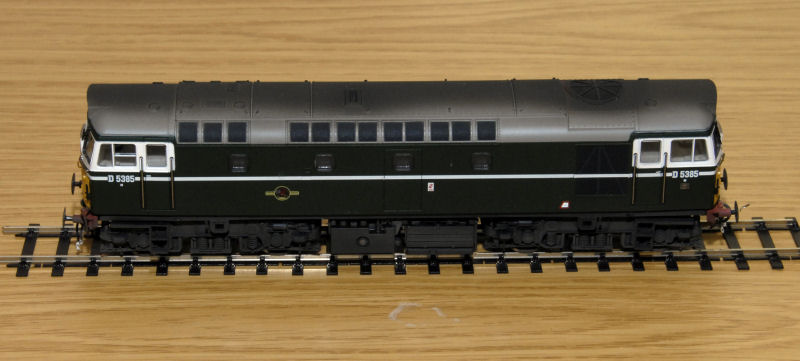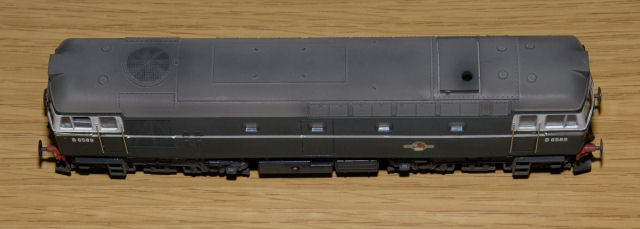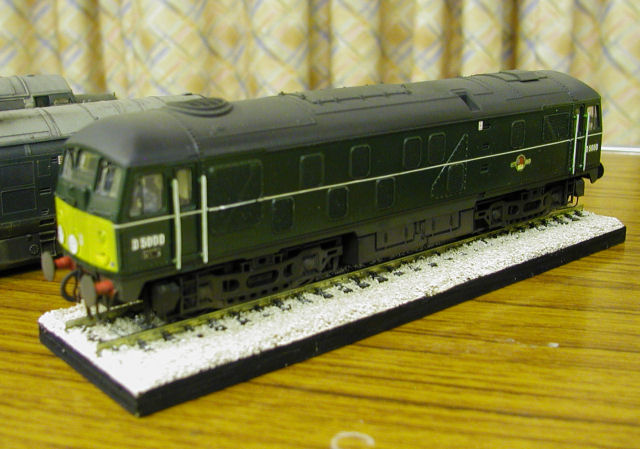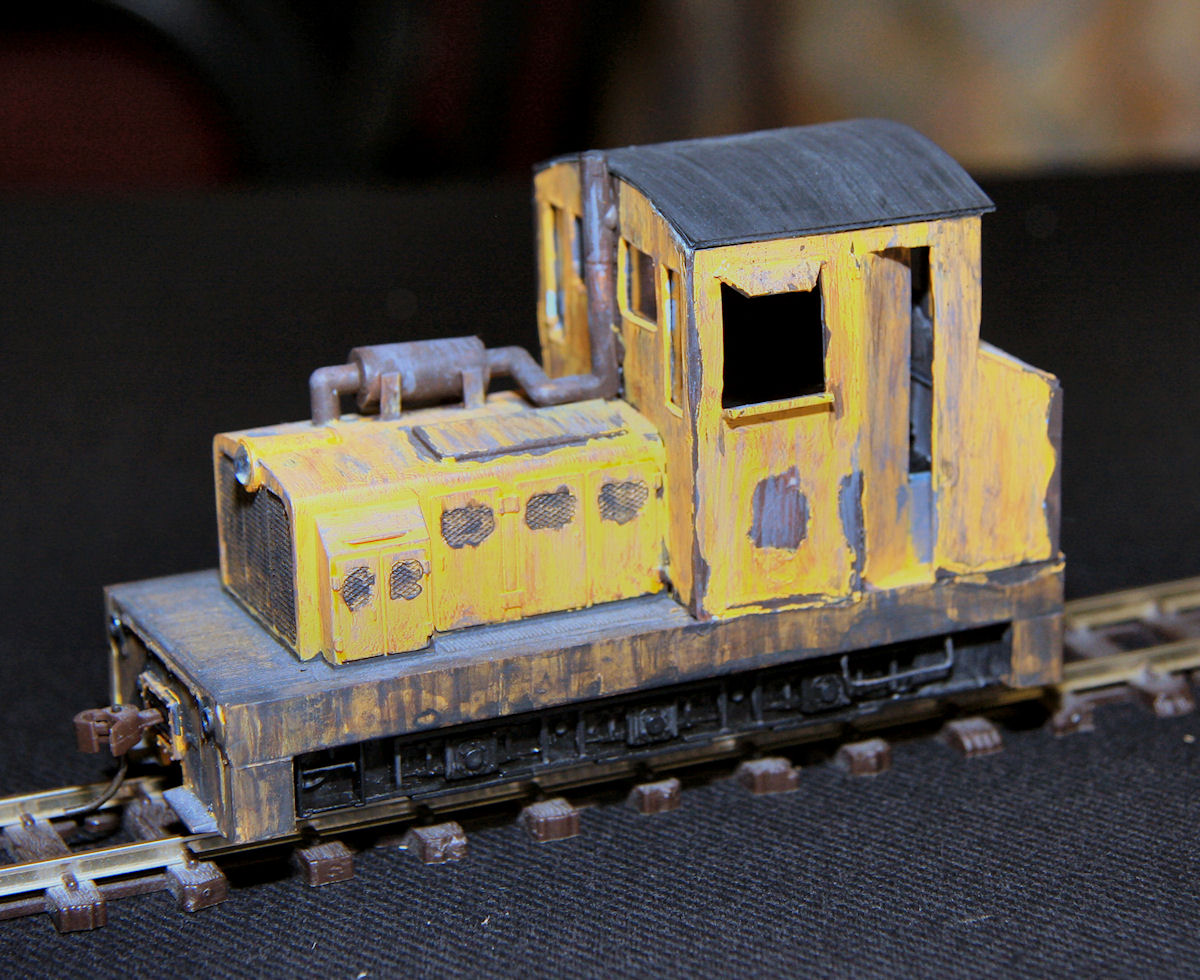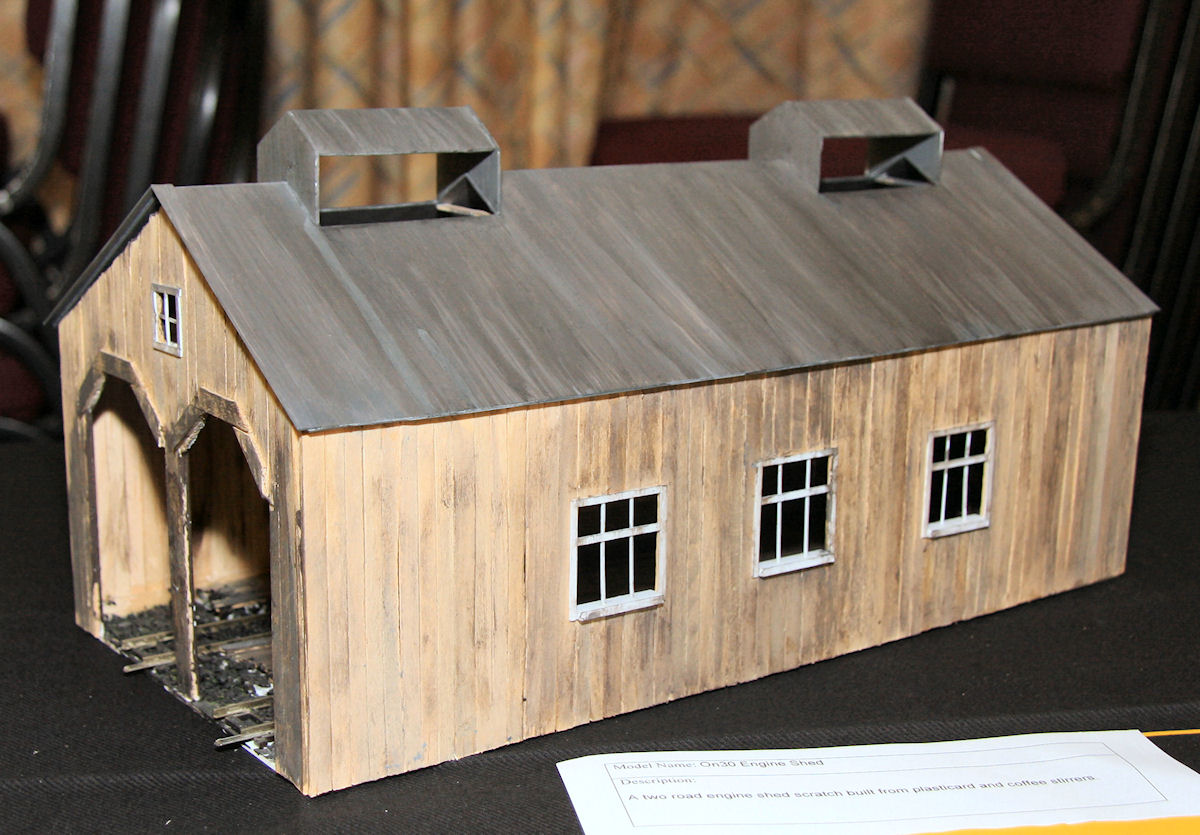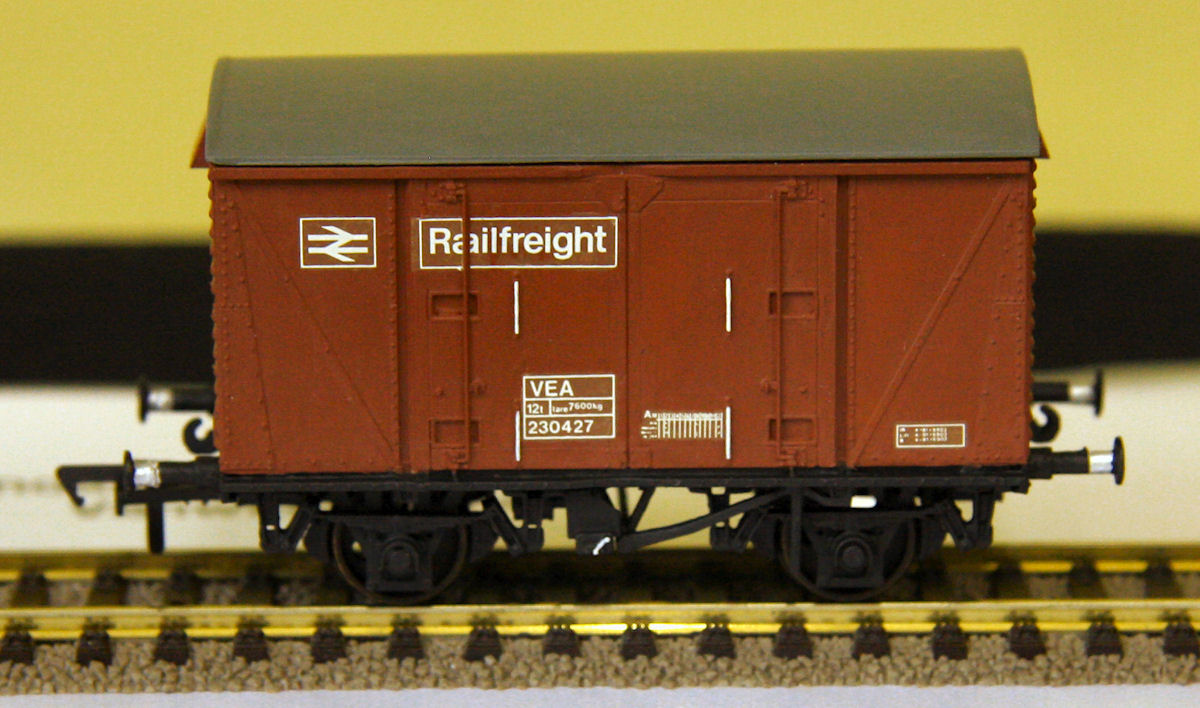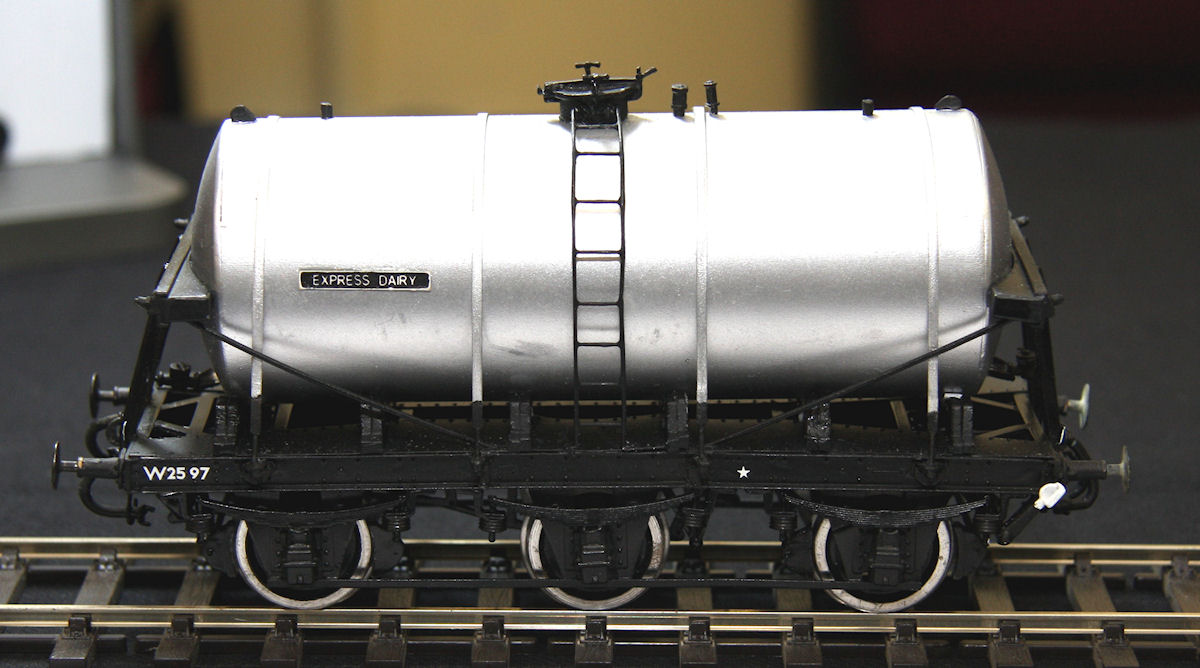Sidebar
Members’ Models 2006 - 2012
The models on this page have been produced by the following club members: Mick Moignard, Paul Wright, Tim Peacock, James Aitken, Steve Probets, David Lane, Ian Gearing, Ian Roll, Richard Turner, Kevin Wood, Max Brayne, Andy Brayne, David Pitcher, Harry Tame, Ted Smale, Pete Miller, Adrian Harford
Mick Moignard
Mick models extensively the Narrow Gauge Denver and Rio Grande Western Railroad in HOn3 (3 foot gauge, 10.5mm track gauge).
K-28s number #478. The 10 K-28s, built by Alco in 1923, for the D&RGW as it came out of its periodic bankruptcies were mostly used in passenger service. Known as Sports Models because of their long, low appearance, they were the tandem power of the San Juan Express and the Shavano, as well as the Chili line trains to Santa Fe. These still exist, including #478, on the Durango and Silverton line. This model was originally made in Japan in 1960 for PFM; one of the earliest HOn3 brass models made. It was obtained, unpainted and unloved in 1987. Since then it has been completely rebuilt with many new details, and remotored with a Mashima can motor and given DCC. This enabled a complete and detailed cab interior to be made. The model was airbrushed with off-black paint, and lightly weathered to represent #478 as she appeared in 1951.
 D&RGW K-28 class #476. The ten K-28 “Sports Model” 2-8-2s were built by Alco in 1928 to start the modernisation of the Narrow Gauge. #476 is depicted as she was in 1951 when she hauled the San Juan Express between Alamosa and Durango. The model is an extensively rebuit Westside brass model, completely redetailed from photos. Added detail includes tender brake gear and new rail frogs, door detail on the doghouse, reworked running boards on the right hand side of the loco, reworking much of the loco piping, adding flag and fuse box on the smokebox left side, airpump access step on the pilot beam and bash plates on the piolt. Note also the foward tilt of the tender because of the heavy coal load. Painted with Railmatch paint, baked, and lettered with Tinfilm decals. Weathering by airbrush, washes, powders, inks and Rustall. 476 is fitted with DCC and Soundtraxx Tsunami sound in the tender together with a GMR chuff cam on the #2 axle.
D&RGW K-28 class #476. The ten K-28 “Sports Model” 2-8-2s were built by Alco in 1928 to start the modernisation of the Narrow Gauge. #476 is depicted as she was in 1951 when she hauled the San Juan Express between Alamosa and Durango. The model is an extensively rebuit Westside brass model, completely redetailed from photos. Added detail includes tender brake gear and new rail frogs, door detail on the doghouse, reworked running boards on the right hand side of the loco, reworking much of the loco piping, adding flag and fuse box on the smokebox left side, airpump access step on the pilot beam and bash plates on the piolt. Note also the foward tilt of the tender because of the heavy coal load. Painted with Railmatch paint, baked, and lettered with Tinfilm decals. Weathering by airbrush, washes, powders, inks and Rustall. 476 is fitted with DCC and Soundtraxx Tsunami sound in the tender together with a GMR chuff cam on the #2 axle.
 D&RGW Boxcar #3446. This has been made from the venerable Railline injection moulded plastic kit, with the few errors that Railline made corrected: side grab irons too short, missing coupler lift bar. #3446 was one of the cars used for hauling foodstuffs, as can be seen from the tackboard “Flour Sugar and Bean Loading Only”. Just another one of the whole herd of these boxcars; by 1951 no two were identical. #3446's paint, applied in 1945, has started to sun-fade and whiten on the sides. The side numbers have been more recently refreshed, as been the paint on the metal roof. The roofwalks are not painted by Federal mandate, though there are hints of overspray from the roof repaint job a few months ago. The model paint is Railmatch with Thinflim decals, with the decals then tinned and weathered by sanding. Weathering is washes and inks, and the body faded with alcohol.
D&RGW Boxcar #3446. This has been made from the venerable Railline injection moulded plastic kit, with the few errors that Railline made corrected: side grab irons too short, missing coupler lift bar. #3446 was one of the cars used for hauling foodstuffs, as can be seen from the tackboard “Flour Sugar and Bean Loading Only”. Just another one of the whole herd of these boxcars; by 1951 no two were identical. #3446's paint, applied in 1945, has started to sun-fade and whiten on the sides. The side numbers have been more recently refreshed, as been the paint on the metal roof. The roofwalks are not painted by Federal mandate, though there are hints of overspray from the roof repaint job a few months ago. The model paint is Railmatch with Thinflim decals, with the decals then tinned and weathered by sanding. Weathering is washes and inks, and the body faded with alcohol.
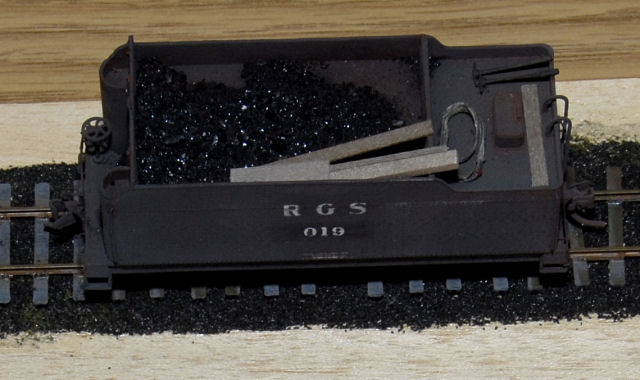 RGS ex-tender Water Car 019. Old tenders make useful water cars for work gangs, supplying extra water for locos, as well as for concrete mixing and other tasks. The coal space is also used to carry fuel for bunk car stoves, cabooses and occasionally for locos. 019 is was made from photos of the prototype as it was in 1945. The basis is an MDC tender kit. New underframe brake gear detail was added, along with handbrake and a couple on the front end, new handrails and all body details, including all the piping and a new ladder. It's been painted, lettered and weathered to match the available photos, including adding a reasonable bunker fill of coal.
RGS ex-tender Water Car 019. Old tenders make useful water cars for work gangs, supplying extra water for locos, as well as for concrete mixing and other tasks. The coal space is also used to carry fuel for bunk car stoves, cabooses and occasionally for locos. 019 is was made from photos of the prototype as it was in 1945. The basis is an MDC tender kit. New underframe brake gear detail was added, along with handbrake and a couple on the front end, new handrails and all body details, including all the piping and a new ladder. It's been painted, lettered and weathered to match the available photos, including adding a reasonable bunker fill of coal.
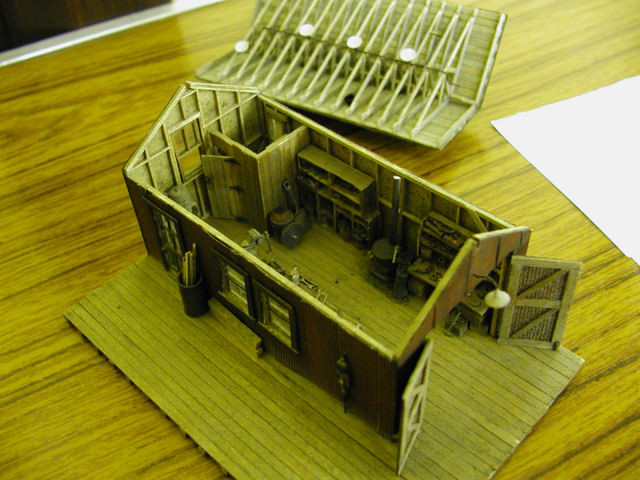 Small Machine Shop in HO. This started out as an S&S models kit, which the end was used for some of the plans and the wood. It is fully framed, including the roof, lined with tarpaper, and rusted (etched in ferric chloride) aluminium corrugated siding applied. Windows are cast whitemetal parts from the original kit, wooden framing on the inside. The interior is fully detailed down to a missing lightbulb in one of the lights. Note the very fine detail in the toilet, and the all the door latches and bolts. Interior details include some of the original kit parts, along with resin details from Sierra West and from others. Note detail down to the electric cable to the grinder, coal and kindling wood for the stove.
Small Machine Shop in HO. This started out as an S&S models kit, which the end was used for some of the plans and the wood. It is fully framed, including the roof, lined with tarpaper, and rusted (etched in ferric chloride) aluminium corrugated siding applied. Windows are cast whitemetal parts from the original kit, wooden framing on the inside. The interior is fully detailed down to a missing lightbulb in one of the lights. Note the very fine detail in the toilet, and the all the door latches and bolts. Interior details include some of the original kit parts, along with resin details from Sierra West and from others. Note detail down to the electric cable to the grinder, coal and kindling wood for the stove.
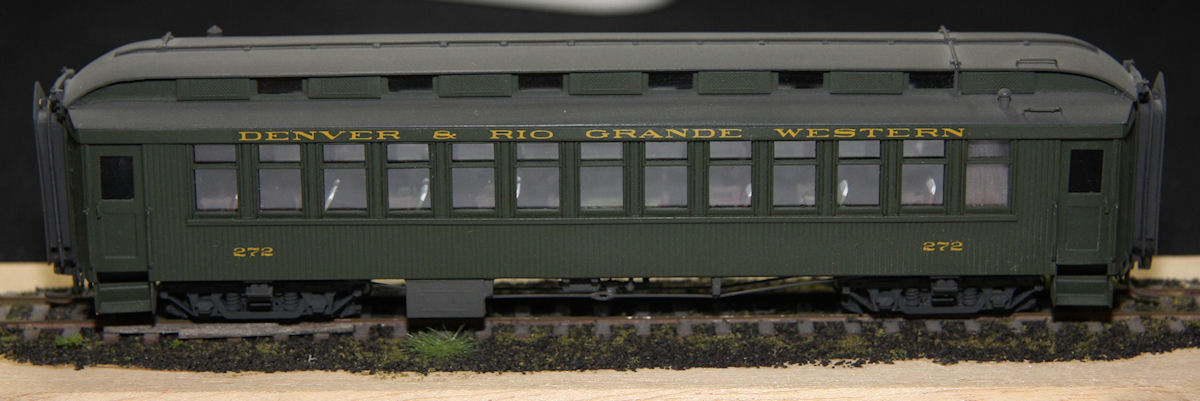 D&RGW Coach #272. #272 was one of the coaches used for the Shavano train between Salida and Gunnison Co, until the Shavano was discontinued in 1941. Moved to Durango, it was fire-damaged in 1947, but the carbody is rumoured to have survived. The model is a reworked Soho brass model. It has all-new underframe detail, mostly scratchbuilt, including see through Grandt brass turnbuckles. It is fitted with Labelle trucks complete with rib-back wheels, and Kadee couplers and new end brake hose and coupler pin pull levers.
The car body has new small details: grabirons, door handles, roof lighting conduits and other roof details, and had been fitted with telescopic gangways designed to reproduce the apperance of the prototype, yet fully articulated so that they keep in touch of the those on adjacent cars down to below 24 inch radius. The carbody and floor were sandblasted after construction, airbrushed, and decaled with Thinfilm decals before light weathering was applied. A detailed interior was then added: stove and coal bin, panelled toilet doors (not that you can see them) and Grandt sets modified to the two-and-one configuration along with the centre sofas, and painted to match surviving photos.
D&RGW Coach #272. #272 was one of the coaches used for the Shavano train between Salida and Gunnison Co, until the Shavano was discontinued in 1941. Moved to Durango, it was fire-damaged in 1947, but the carbody is rumoured to have survived. The model is a reworked Soho brass model. It has all-new underframe detail, mostly scratchbuilt, including see through Grandt brass turnbuckles. It is fitted with Labelle trucks complete with rib-back wheels, and Kadee couplers and new end brake hose and coupler pin pull levers.
The car body has new small details: grabirons, door handles, roof lighting conduits and other roof details, and had been fitted with telescopic gangways designed to reproduce the apperance of the prototype, yet fully articulated so that they keep in touch of the those on adjacent cars down to below 24 inch radius. The carbody and floor were sandblasted after construction, airbrushed, and decaled with Thinfilm decals before light weathering was applied. A detailed interior was then added: stove and coal bin, panelled toilet doors (not that you can see them) and Grandt sets modified to the two-and-one configuration along with the centre sofas, and painted to match surviving photos.
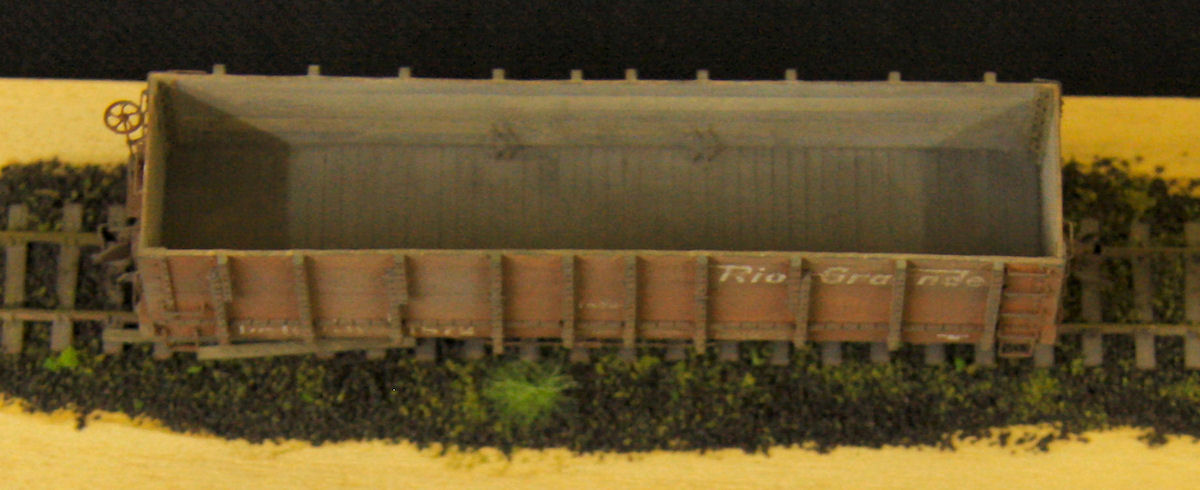 D&RGW Gondola #1872. Scratch-built using a wooden superstructure and underframe, with scribed lead floor for weight and operation. Details are a mixture of scratchbuilt parts and some commercial plastic parts from Grandt Line. Nut/bolt/washer castings used for each grabiron. Complete underframe detail, brake gear, etc. Grandt Line trucks and Kadee couplers. Painted with an airbrush and weathered with washes, powders and real dirt. Drawings and info from Model Railroader articles, Sloan Century + 10 block and multitudinous photos.
D&RGW Gondola #1872. Scratch-built using a wooden superstructure and underframe, with scribed lead floor for weight and operation. Details are a mixture of scratchbuilt parts and some commercial plastic parts from Grandt Line. Nut/bolt/washer castings used for each grabiron. Complete underframe detail, brake gear, etc. Grandt Line trucks and Kadee couplers. Painted with an airbrush and weathered with washes, powders and real dirt. Drawings and info from Model Railroader articles, Sloan Century + 10 block and multitudinous photos.
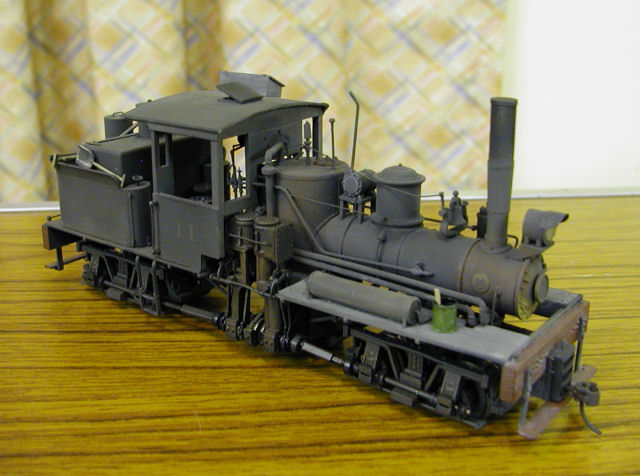 2 Truck Shay #11 is a reworked Bachmann, which has been detailed to represent a loco that has had a long and useful life and which has had many medications over the years. It's now oil fired, though it still carriers an ashpan. New details include the chimney made from a brass casting and a mesh arrestor, airpump, tank and piping, water siphon tube under the left side footplate, extra cab interior details, plated over cab sides, new steps an many other details including the characteristic grease can be found on the footplate for the driveshaft gears. Details are a mixture of scratch and commercial items. The loco was completely dismantled and reassembled more carefully that the factory job. Painted and heavily weathered. It has DCC, lights and synchronised sound using a Soundtrax decoder.
2 Truck Shay #11 is a reworked Bachmann, which has been detailed to represent a loco that has had a long and useful life and which has had many medications over the years. It's now oil fired, though it still carriers an ashpan. New details include the chimney made from a brass casting and a mesh arrestor, airpump, tank and piping, water siphon tube under the left side footplate, extra cab interior details, plated over cab sides, new steps an many other details including the characteristic grease can be found on the footplate for the driveshaft gears. Details are a mixture of scratch and commercial items. The loco was completely dismantled and reassembled more carefully that the factory job. Painted and heavily weathered. It has DCC, lights and synchronised sound using a Soundtrax decoder.
 Ridgway Sand House, Ridgway, Colorado was at the northern end of the Rio Grande Southern and junction with the D&RGW Ocray branch. At Ridgway was the RGS Shops and main engine terminal. A constant supply of fine, dry and filtered sand was required to ensure that locos where as ready as they could be to tackle the 4% (1 in 25) grades south to Dallas Divide and beyond. The model is an updated and redetailed Branta laser-cut kit, and has been made up as a mini- diorama as the prototype was in around 1949, before the sand bin collapsed. The kit has been carefully painted to match available colour photos, including the damaged tar paper roof, the now unused return sand chute propped up on an oil drum, and the old and cut off sand delivery pipe. Weeds and bushes are growing at the far end of the bin, as less sand is required for the fading steam freight service.
Ridgway Sand House, Ridgway, Colorado was at the northern end of the Rio Grande Southern and junction with the D&RGW Ocray branch. At Ridgway was the RGS Shops and main engine terminal. A constant supply of fine, dry and filtered sand was required to ensure that locos where as ready as they could be to tackle the 4% (1 in 25) grades south to Dallas Divide and beyond. The model is an updated and redetailed Branta laser-cut kit, and has been made up as a mini- diorama as the prototype was in around 1949, before the sand bin collapsed. The kit has been carefully painted to match available colour photos, including the damaged tar paper roof, the now unused return sand chute propped up on an oil drum, and the old and cut off sand delivery pipe. Weeds and bushes are growing at the far end of the bin, as less sand is required for the fading steam freight service.
Paul Wright
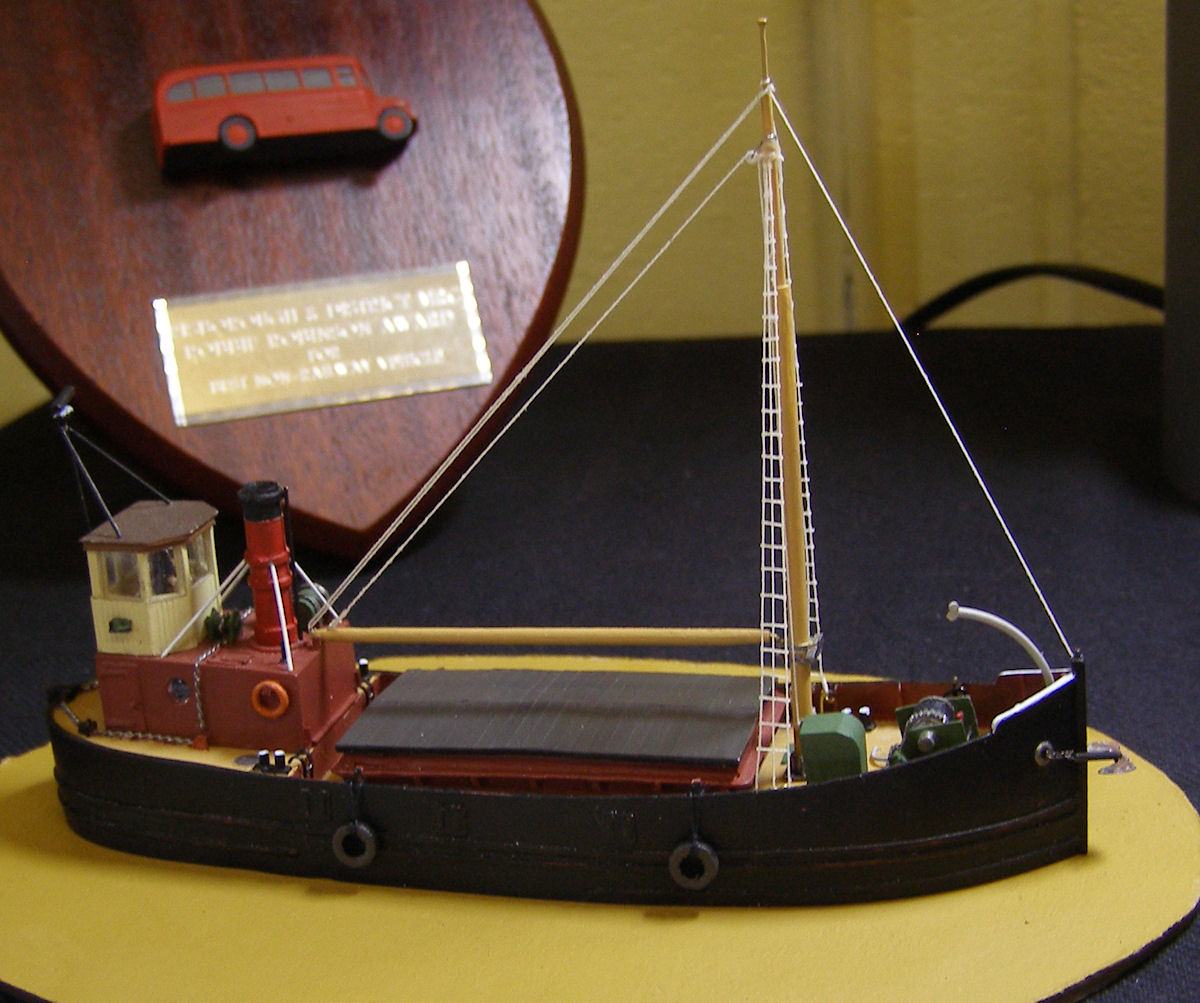 1:152 Clyde Puffer. the main structure is a resin casting from GRA Models. All the details have had to be scratchbuilt including: mast & boom, anchor, radar, rigging & ropework, hold planking, etc. The winch is a greatly modified resin casting from the kit with brass pipework and cotton rope.
1:152 Clyde Puffer. the main structure is a resin casting from GRA Models. All the details have had to be scratchbuilt including: mast & boom, anchor, radar, rigging & ropework, hold planking, etc. The winch is a greatly modified resin casting from the kit with brass pipework and cotton rope.
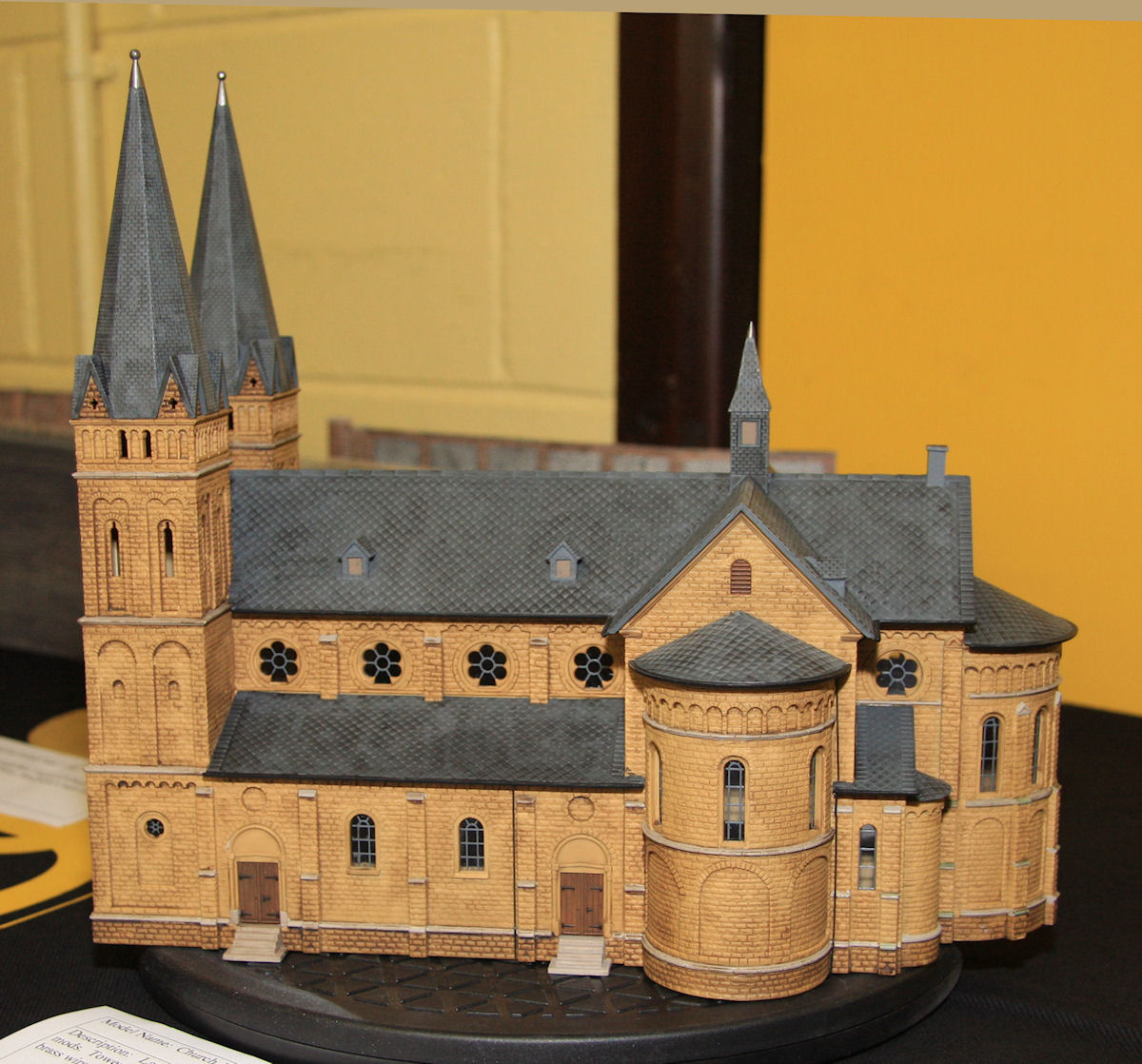 Church 1:160. A large European church built from a Kirbi kit with some mods. Tower end leaded window is a home made decal, downpipes from brass wire. Painted and weathered with acrylics.
Church 1:160. A large European church built from a Kirbi kit with some mods. Tower end leaded window is a home made decal, downpipes from brass wire. Painted and weathered with acrylics.
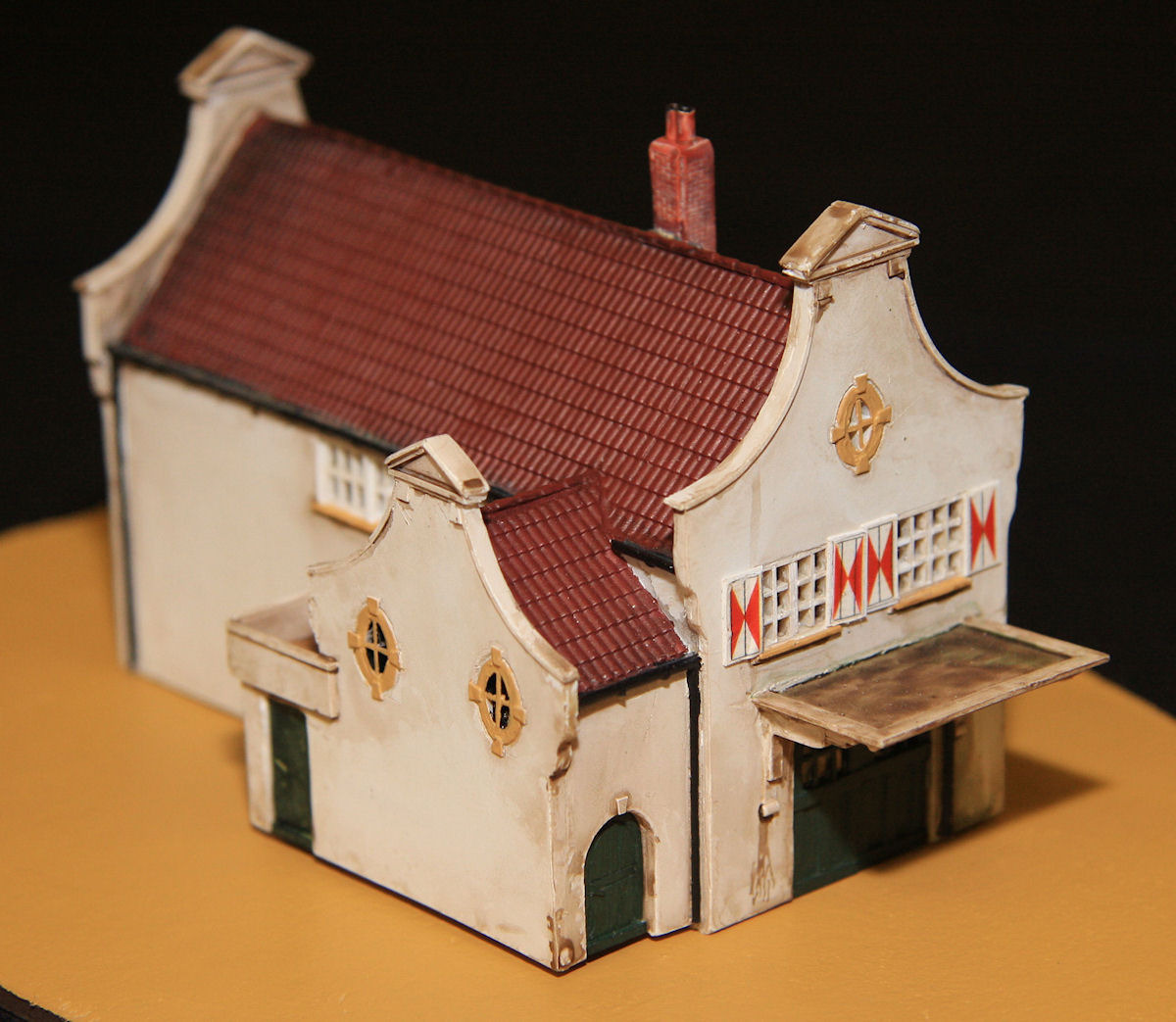 Dutch Coach House 1;160. This is a resin kit by Tilly Models and is a copy of an existing building in Nijmegan. The shutters are plastic strip and home made decals. The prototype is now part of a bank. Painted in acrylics.
Dutch Coach House 1;160. This is a resin kit by Tilly Models and is a copy of an existing building in Nijmegan. The shutters are plastic strip and home made decals. The prototype is now part of a bank. Painted in acrylics.
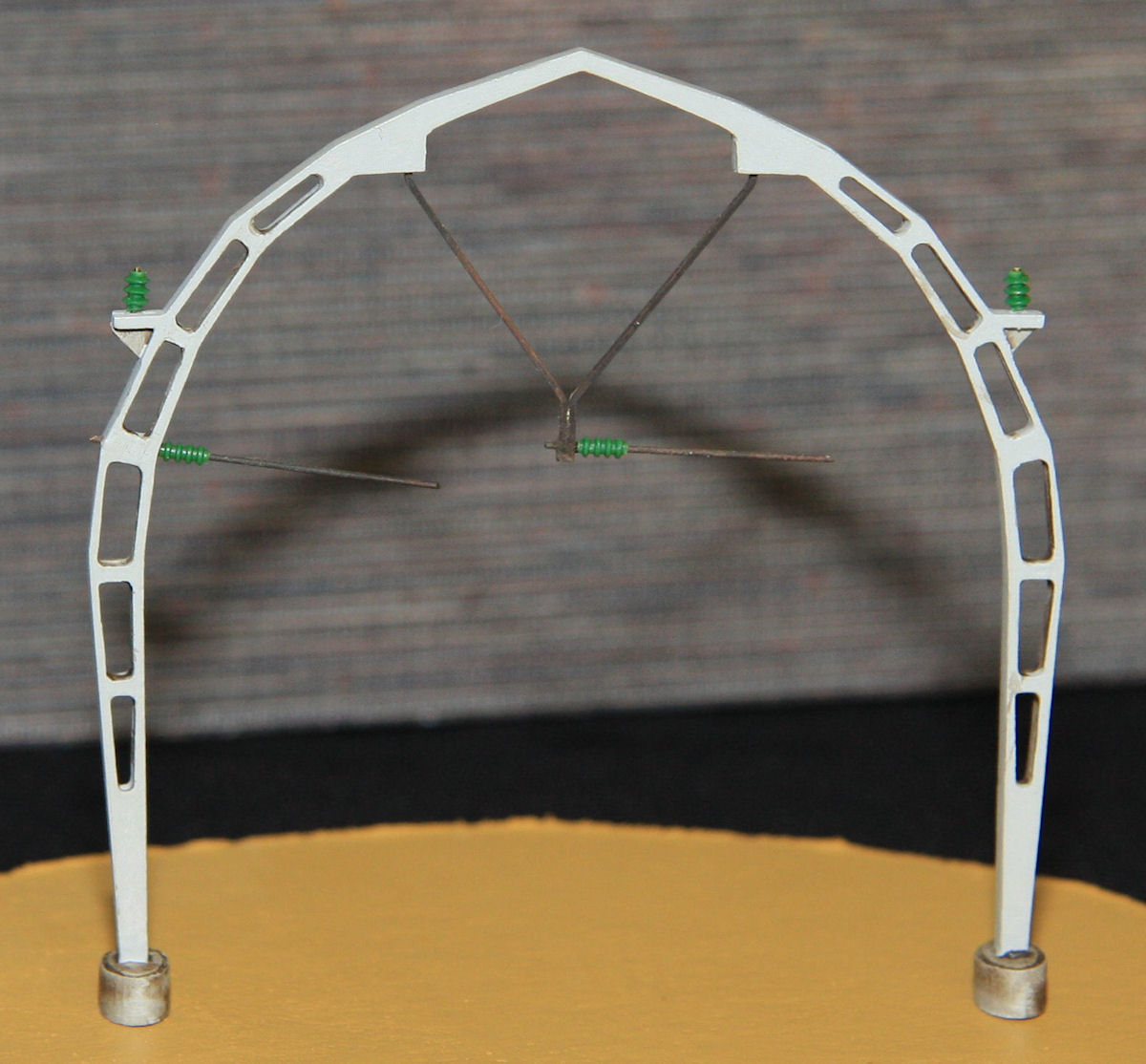 Dutch Concrete Catenary Mast 1:160. The main frame is made from 3 layers of 0.8mm ply that was laser cut by Hogos Finest in Germany. Metalwork is brass rod and isolators are from Sommerfeldt.
Dutch Concrete Catenary Mast 1:160. The main frame is made from 3 layers of 0.8mm ply that was laser cut by Hogos Finest in Germany. Metalwork is brass rod and isolators are from Sommerfeldt.
 1:48 scale, Austen Light Utility Car 10HP, known as the “Tilly”, made from a Tamyia kit, painted in acrylics.
1:48 scale, Austen Light Utility Car 10HP, known as the “Tilly”, made from a Tamyia kit, painted in acrylics.
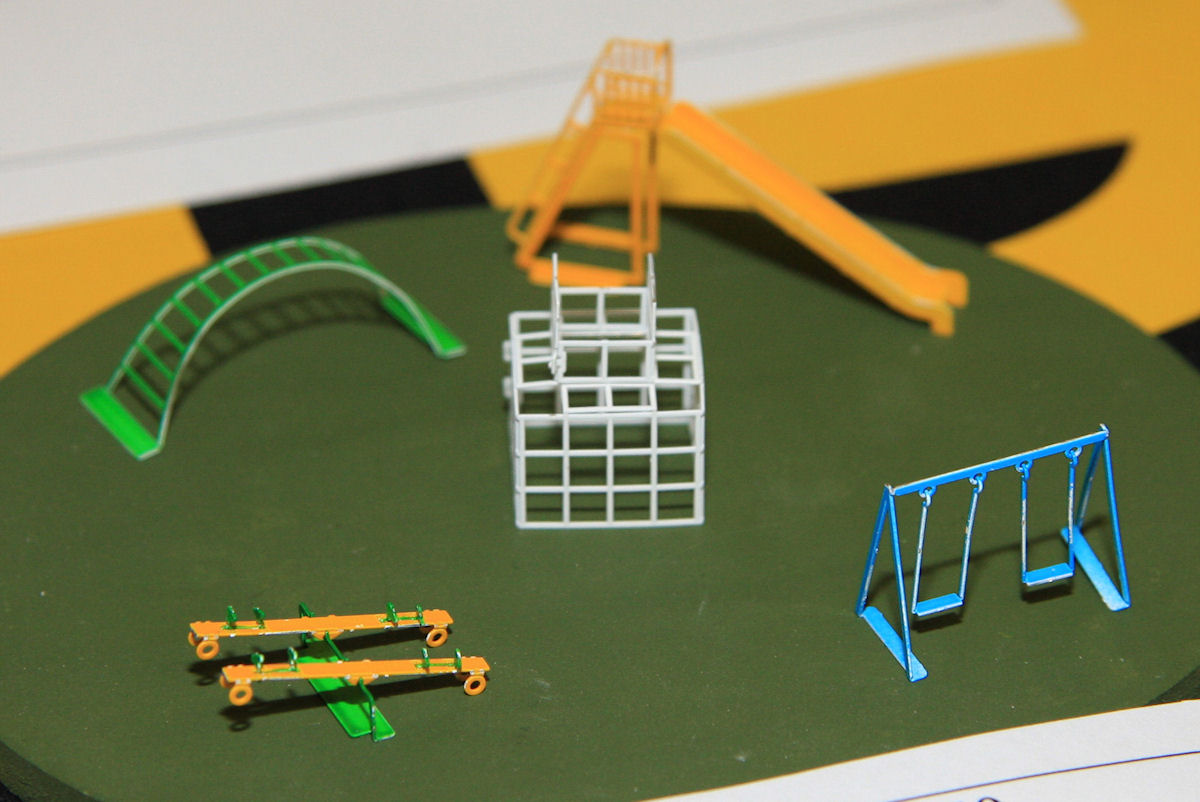 Playground Equipment. Etched brass playground equipment by Pro Hoppy of Japan, swings and seasaws will work
Playground Equipment. Etched brass playground equipment by Pro Hoppy of Japan, swings and seasaws will work
 The ship modelled here was built in 1912 in Alkmaar, the Netherlands. It used a one-cylinder Steynwall engine of 45 PS, and was owned by a Dutch concrete firm from The Hague. Ships like this one (the HBM 10) were in active use until the 1970’s, transporting all kinds of tows through canals. Lighters are used for all kinds of things: as a platform for cranes, as a tow, as a floating terrace in the Amsterdam canals.
The ship modelled here was built in 1912 in Alkmaar, the Netherlands. It used a one-cylinder Steynwall engine of 45 PS, and was owned by a Dutch concrete firm from The Hague. Ships like this one (the HBM 10) were in active use until the 1970’s, transporting all kinds of tows through canals. Lighters are used for all kinds of things: as a platform for cranes, as a tow, as a floating terrace in the Amsterdam canals.
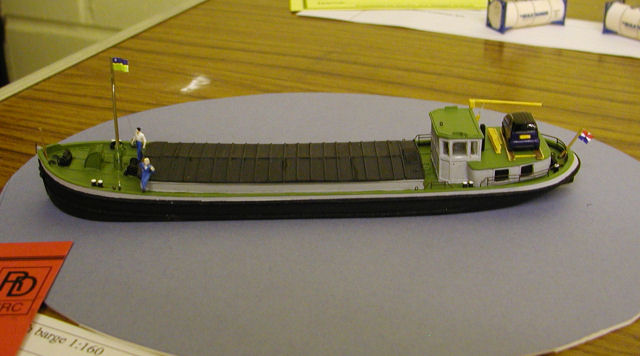 Dutch Barge in 1:160 scale. The barge made from resin and etched brass Artitec kit. The smartcar is made by Busch, the figures by Preiser (painted by myself) and the crane is scratch built. The flags are produced on a laser printed and the Civil jack on the stern and the flag of Flavoland on the mast. The mast stays are made from 0.05mm wire.
Dutch Barge in 1:160 scale. The barge made from resin and etched brass Artitec kit. The smartcar is made by Busch, the figures by Preiser (painted by myself) and the crane is scratch built. The flags are produced on a laser printed and the Civil jack on the stern and the flag of Flavoland on the mast. The mast stays are made from 0.05mm wire.
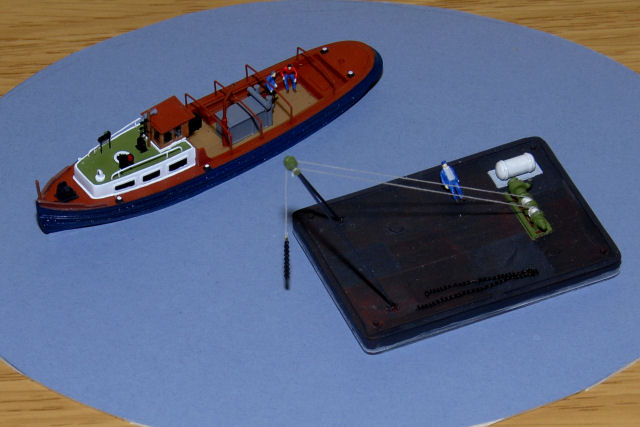 Launch and pontoon crane 1:160. Built from an Artitec kit (resin and brass) with figures from Preiser (painted by Paul).
Launch and pontoon crane 1:160. Built from an Artitec kit (resin and brass) with figures from Preiser (painted by Paul).
Tim Peacock
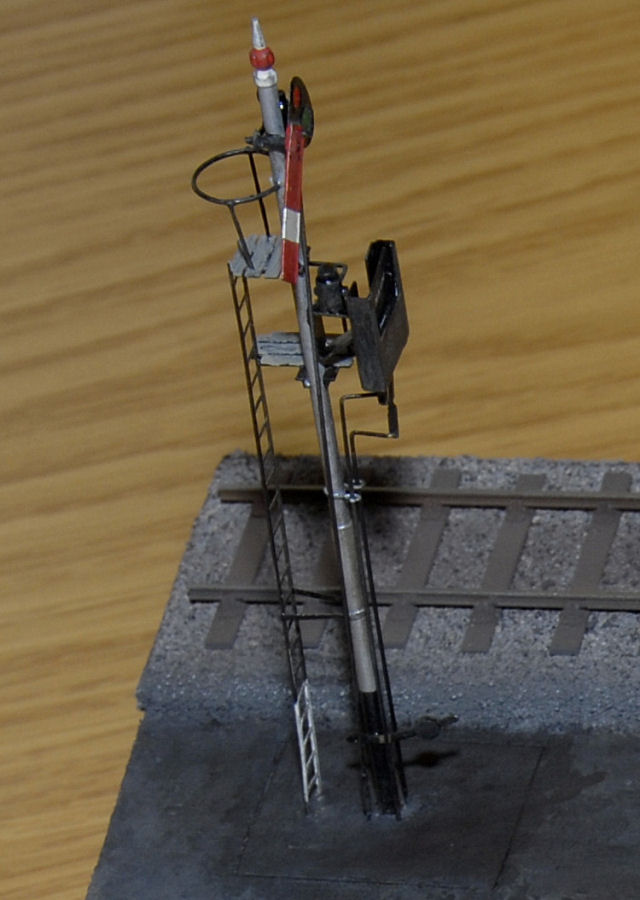 Bay Starter Signal from High Wycombe which is made mostly from MSE parts. The route indicator works and the signal is lit.
Bay Starter Signal from High Wycombe which is made mostly from MSE parts. The route indicator works and the signal is lit.
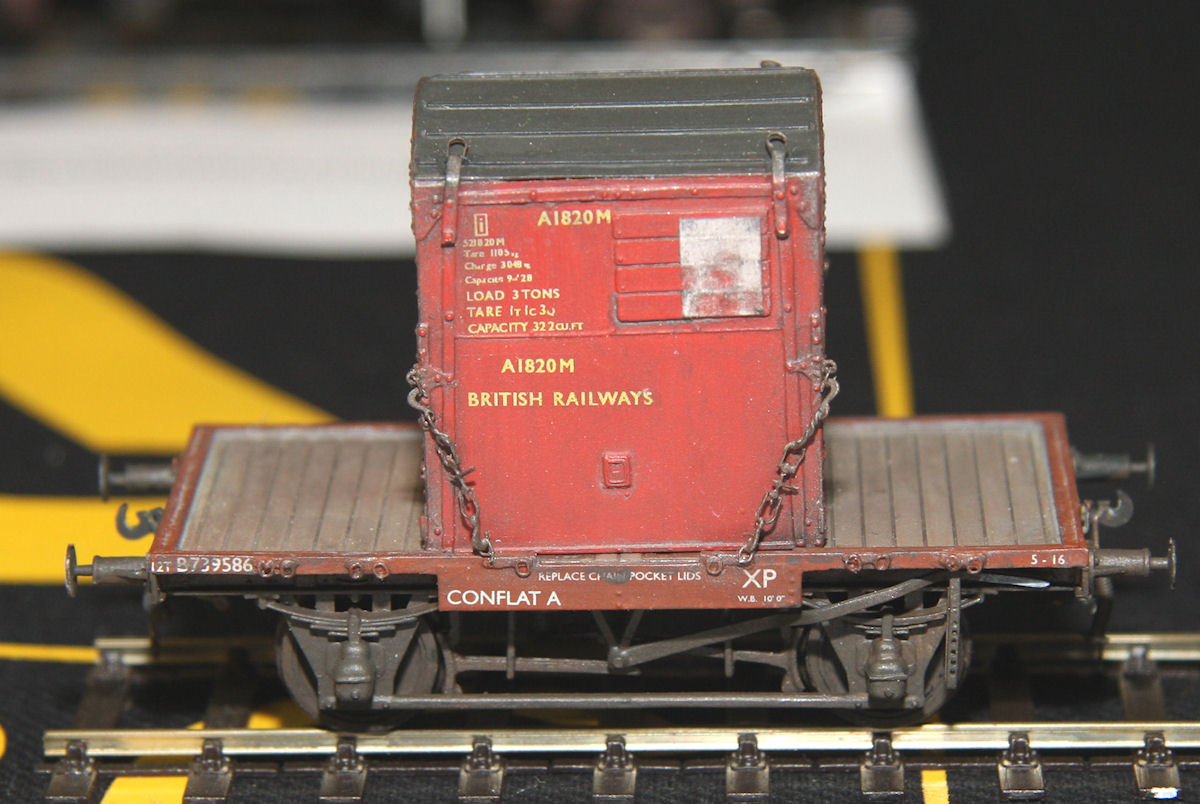 Parkside Conflat and Cambrian Container. Upgraded brake gear and very fiddly anchoring chains from Ambis etches! The lovely container lettering is from Cambridge Custom Transfers.
Parkside Conflat and Cambrian Container. Upgraded brake gear and very fiddly anchoring chains from Ambis etches! The lovely container lettering is from Cambridge Custom Transfers.
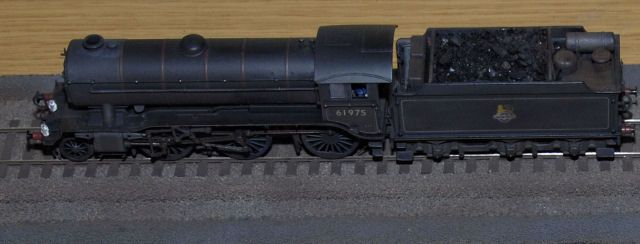 K3 number 61975. A 2-6-0 locomotive which has been re-wheeled to EM and chipped for DCC. The loco has been renumbered and weathered with crew added.
K3 number 61975. A 2-6-0 locomotive which has been re-wheeled to EM and chipped for DCC. The loco has been renumbered and weathered with crew added.
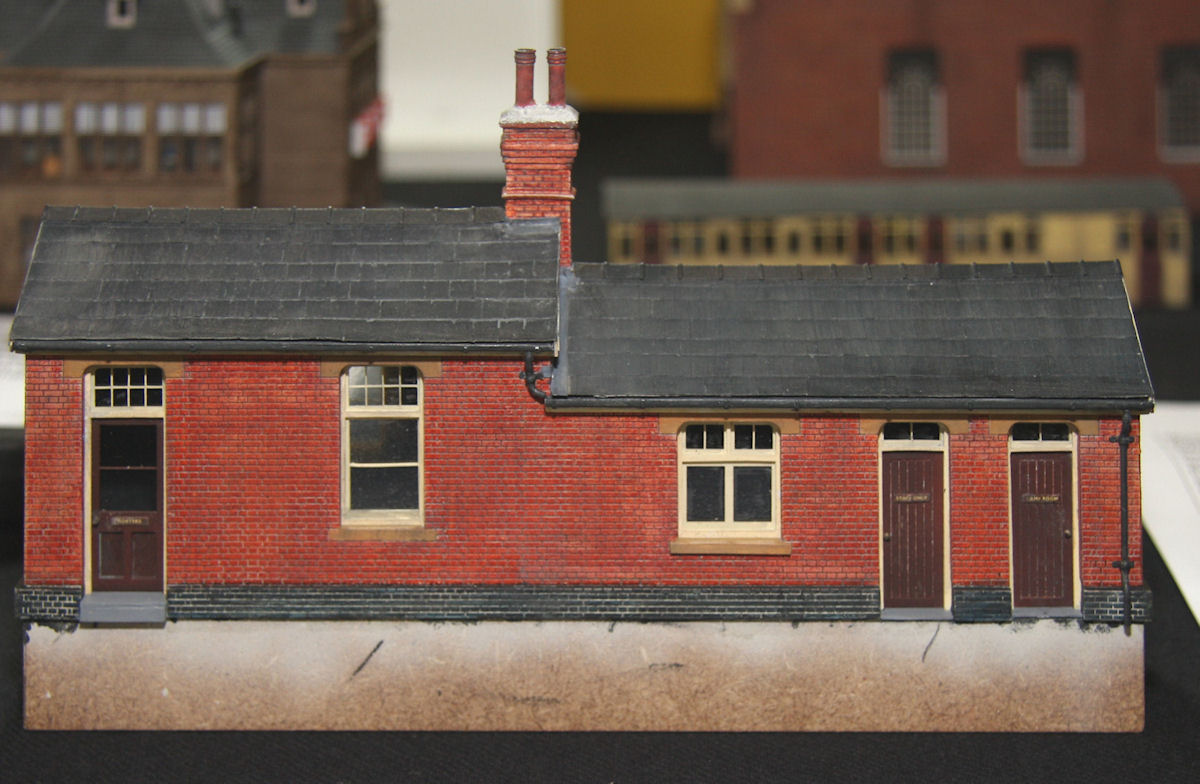 High Wycombe Porters Hut in 4mm scale
High Wycombe Porters Hut in 4mm scale
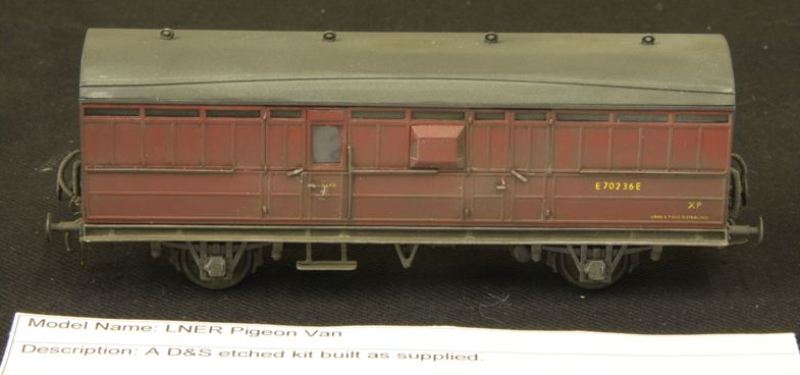 LNER Pigeon Van, a D&S etched kit built as supplied.
LNER Pigeon Van, a D&S etched kit built as supplied.
 Clifton Down Auto Trailer. A Roxey etched brass kit shown as running on the Marlow branch just prior to withdrawal in 1950. It remains in scruffy wartime GW livery.
There is significant extra detailing including scratchbuilt auto gear, interior and representation if sheeted over panels.
Clifton Down Auto Trailer. A Roxey etched brass kit shown as running on the Marlow branch just prior to withdrawal in 1950. It remains in scruffy wartime GW livery.
There is significant extra detailing including scratchbuilt auto gear, interior and representation if sheeted over panels.
 1474 Collett 0-4-2 tank loco. A modified Airfix body with scratchbuilt auto gear and other detailing, running on a Perseverance chassis. Renumbered and weathered.
1474 Collett 0-4-2 tank loco. A modified Airfix body with scratchbuilt auto gear and other detailing, running on a Perseverance chassis. Renumbered and weathered.
James Aitken
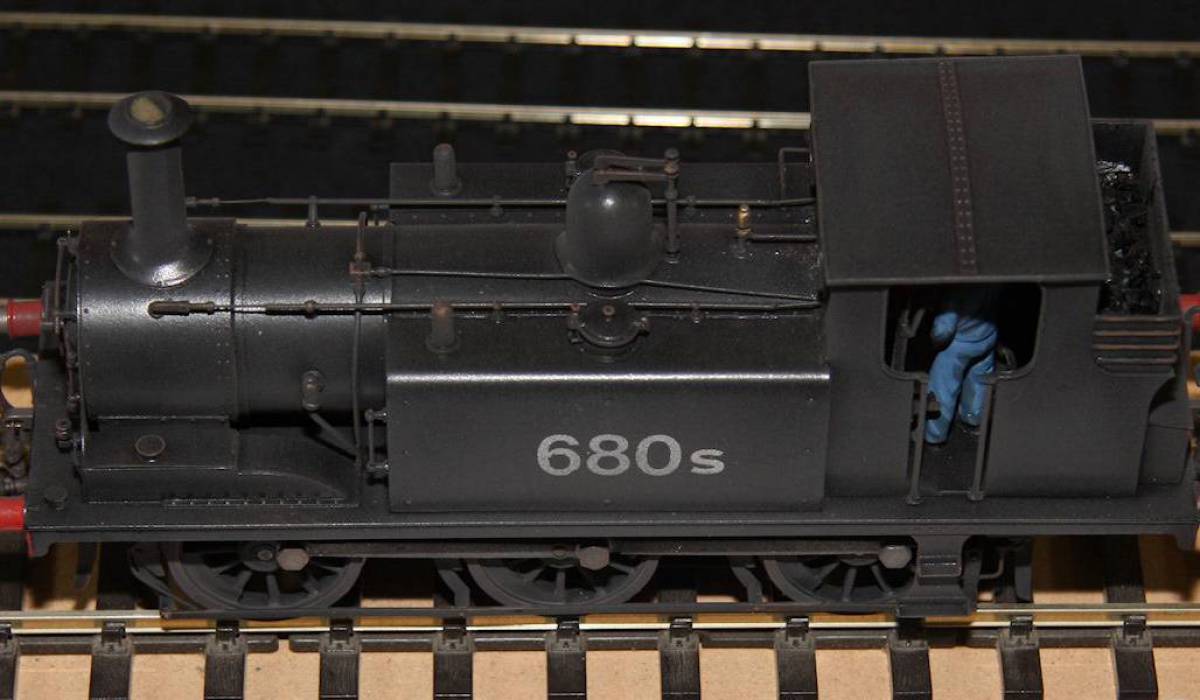 Southern Railway Terrier. This is a Finescale Brass loco, obtained unpainted, and customised by them to provide the original smokebox front plate and the short bunker. James has painted the chassis (having completely dismantled it) and the body in stain black, lettered as the Lancing Carriage Works shunter number 680s. Light weathering has been applied to tone down the shiny black to a dull dirty colour, while the engine ran on a rolling road. It has been fitted with a DCC chip and will in time feature sound. The smokebox door and filler caps open.
Southern Railway Terrier. This is a Finescale Brass loco, obtained unpainted, and customised by them to provide the original smokebox front plate and the short bunker. James has painted the chassis (having completely dismantled it) and the body in stain black, lettered as the Lancing Carriage Works shunter number 680s. Light weathering has been applied to tone down the shiny black to a dull dirty colour, while the engine ran on a rolling road. It has been fitted with a DCC chip and will in time feature sound. The smokebox door and filler caps open.
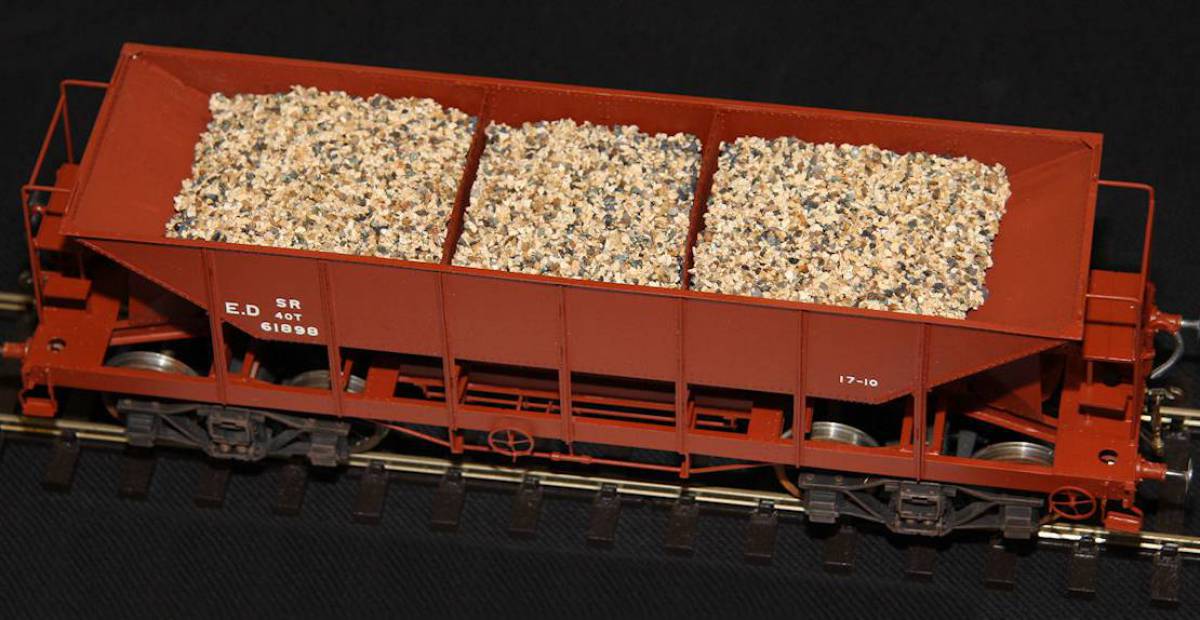 Southern Railway Bogie Ballast Hopper. Made from a Southwark Bridge Models Kit with better buffers and coupling hooks than were supplied in the kit. Painted in bauxite and lettered in SR post 37 style. The kit is wonderfully well thought out with excellent instructions and everything fits properly. Hundreds of small parts though so it took ages to make! The diamond bogies spring in the correct manner.
Southern Railway Bogie Ballast Hopper. Made from a Southwark Bridge Models Kit with better buffers and coupling hooks than were supplied in the kit. Painted in bauxite and lettered in SR post 37 style. The kit is wonderfully well thought out with excellent instructions and everything fits properly. Hundreds of small parts though so it took ages to make! The diamond bogies spring in the correct manner.
 GWR Macaw Bogie Bolster. Built from a Connoisseur kit brought at the Railex exhibition in May last year. Sides bent up using the bending tool sold by JLTRT, which is just long enough. Soldered using 145 degree solder except for the bogies which use low melt solder. First time I've successfully soldered white metal due, I think, to using a temperature-controlled iron for the first time. Weathered using techniques learnt at one of the club's teaching evenings.
GWR Macaw Bogie Bolster. Built from a Connoisseur kit brought at the Railex exhibition in May last year. Sides bent up using the bending tool sold by JLTRT, which is just long enough. Soldered using 145 degree solder except for the bogies which use low melt solder. First time I've successfully soldered white metal due, I think, to using a temperature-controlled iron for the first time. Weathered using techniques learnt at one of the club's teaching evenings.
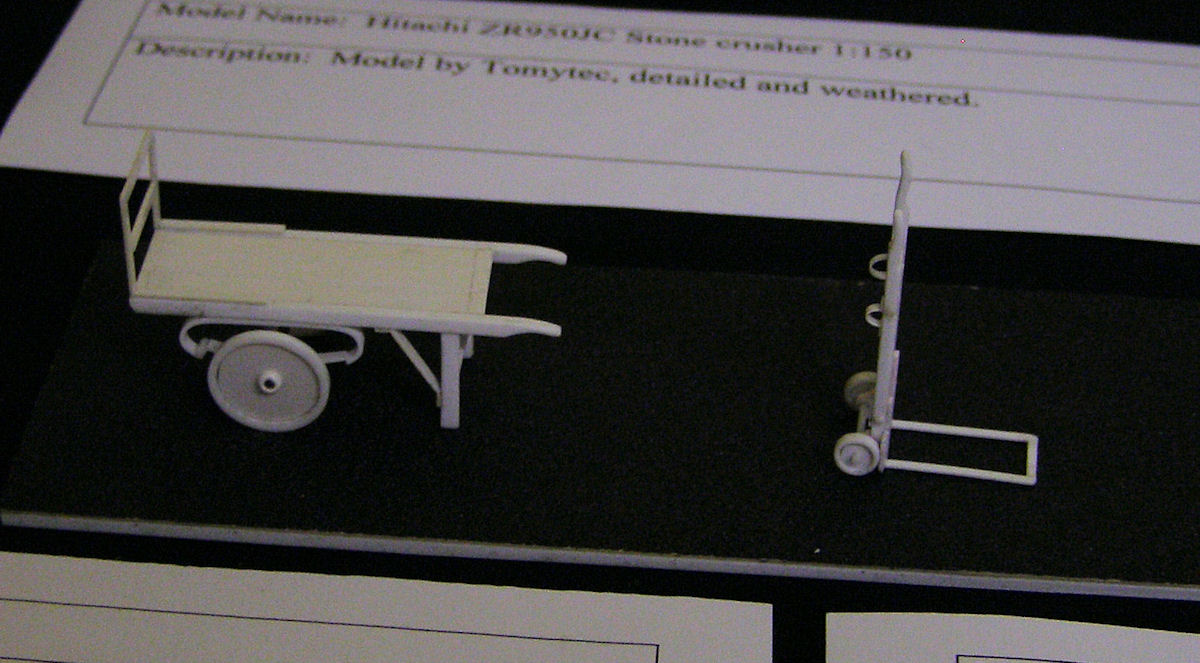 LSWR/SR Luggage Barrow and Long Bow Barrow. A scratchbuild from styrene strip and tube. The square section sidebars, cross bars and legs are laminated from two thicknesses of strip, filed carefully to hide the join. The wheels were made from thin section of half inch styrene tube, with a circular disc welded inside. The disc was cut from 20thou styrene sheet. The springs and spring support is made from 20thou by 60thou strip wrapped round a former and soaked in boiling water to retain the required shape. The barrows are based on a drawing in Weddell's book on LSWR carriages.
LSWR/SR Luggage Barrow and Long Bow Barrow. A scratchbuild from styrene strip and tube. The square section sidebars, cross bars and legs are laminated from two thicknesses of strip, filed carefully to hide the join. The wheels were made from thin section of half inch styrene tube, with a circular disc welded inside. The disc was cut from 20thou styrene sheet. The springs and spring support is made from 20thou by 60thou strip wrapped round a former and soaked in boiling water to retain the required shape. The barrows are based on a drawing in Weddell's book on LSWR carriages.
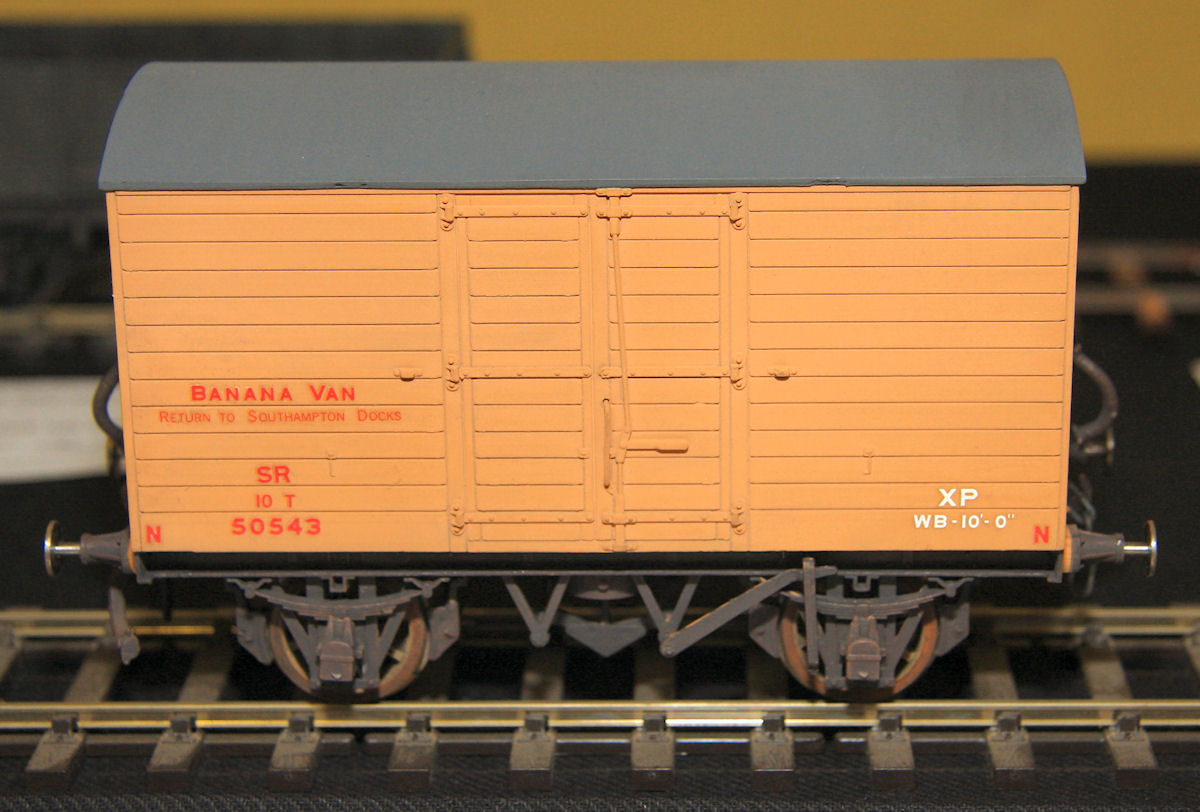 SR Banana Van. A Parkside kit sprayed with Precision Paints and weathered.
SR Banana Van. A Parkside kit sprayed with Precision Paints and weathered.
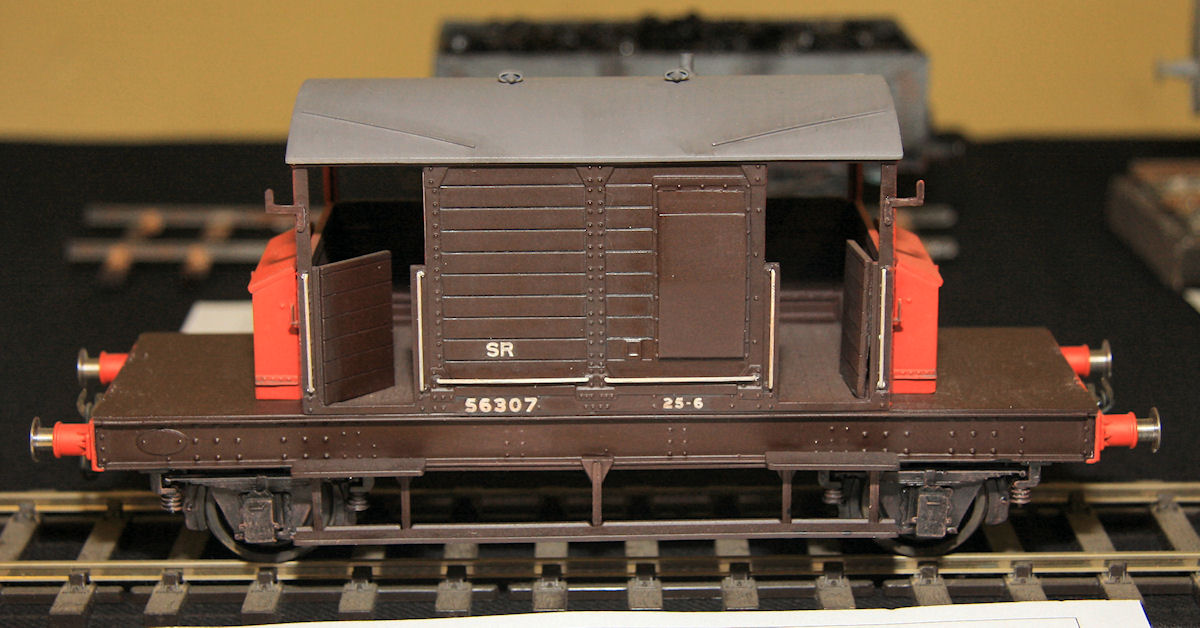 SR Brake Van. A Parkside kit made in SR form with the sand boxes in place. Sprayed with Precision Paints and weathered.
SR Brake Van. A Parkside kit made in SR form with the sand boxes in place. Sprayed with Precision Paints and weathered.
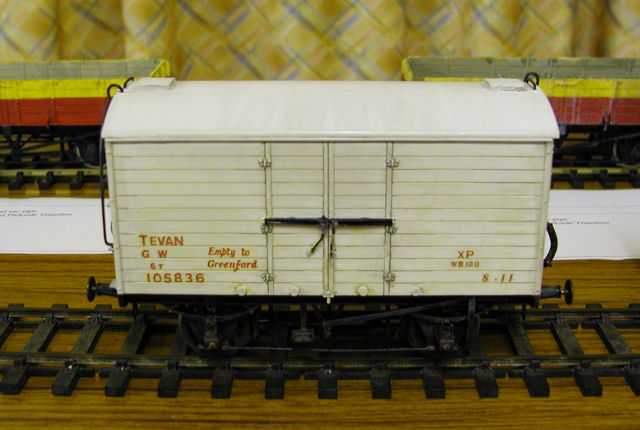 GWR Tevan, built from a Parkside kit. Sprayed white with black chassis. Lettered with HMRS transfers as the ones that came with the kit would not stick. Lightly weathered using techniques learnt at the club.
GWR Tevan, built from a Parkside kit. Sprayed white with black chassis. Lettered with HMRS transfers as the ones that came with the kit would not stick. Lightly weathered using techniques learnt at the club.
Steve Probets
The bridge is made using Wills course stone sheet material. Steve used a compass cutter when cutting out the arches; there were three sheets per side of the bridge. These were then glued together to accommodate the two facing bridge sides. The springer course has been made using strip styrene. The arch liners were made using slaters 4mm Flemish bond brick, red. Strip styrene was used for the coping stones after gluing the bridge together.
The complete bridge was sprayed with Halfords primer grey, then sprayed dove grey, then painted light grey, then wiped with a tissue. After it had dried, Steve used a brush drying technique, using Humbrol paints, no’s 63 30 34 33 for shading in the brick work.
The tree was made using copper wire twisted together. Florist tape was then wrapped around the wire. Steve then mixed black paint with white acrylic flexible sealant and used a brush to put it onto the wire frame. The foliage was then added. For the water effect Steve used woodland scenic realistic water. The grass is green scene underfelt.
David Lane
The Southern PMV has no end doors, the CCT with end doors. The bodies are Parkside with extra details including handrails. The chassis are sprung by Masokits with MJT buffers.
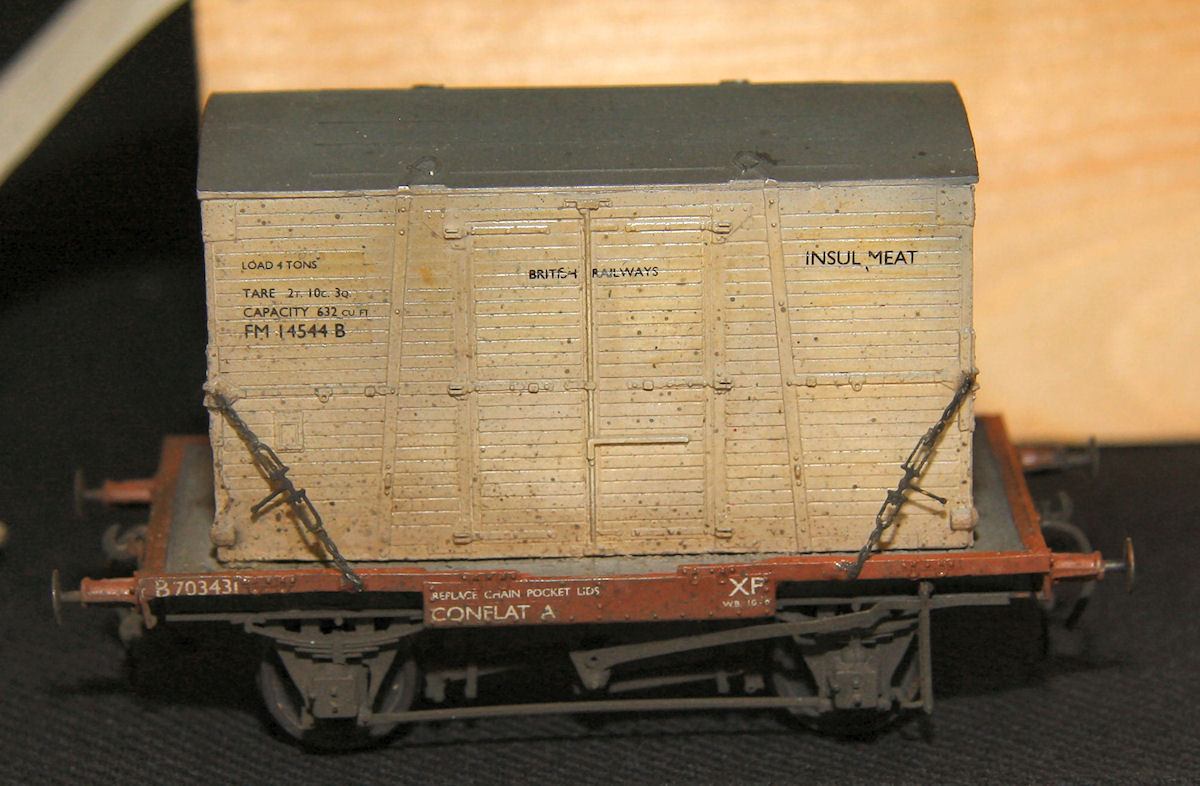 BR Conflat with White Container. A Parkside kit with Masokits underframe detail and extra detail.
BR Conflat with White Container. A Parkside kit with Masokits underframe detail and extra detail.
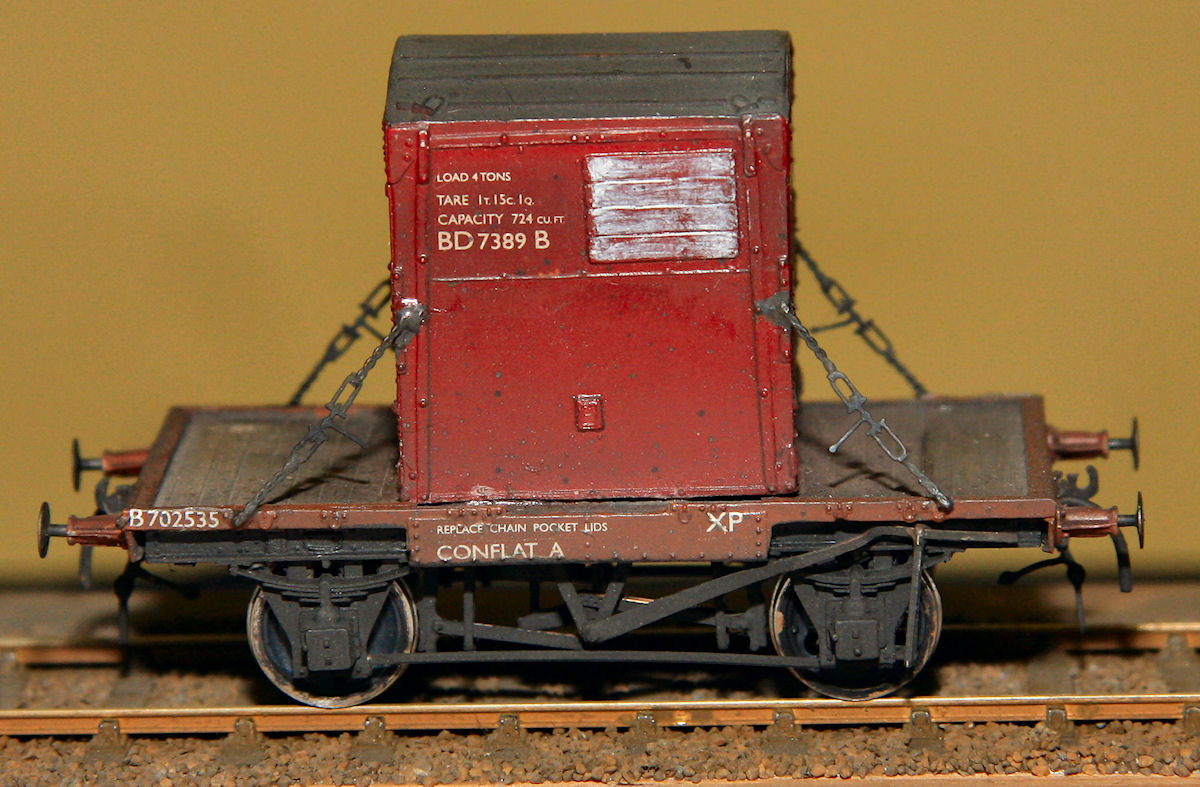 BR Conflat with A Type Container. This was made from a Parkside kit with Masokits underframe and scratch built detail.
BR Conflat with A Type Container. This was made from a Parkside kit with Masokits underframe and scratch built detail.
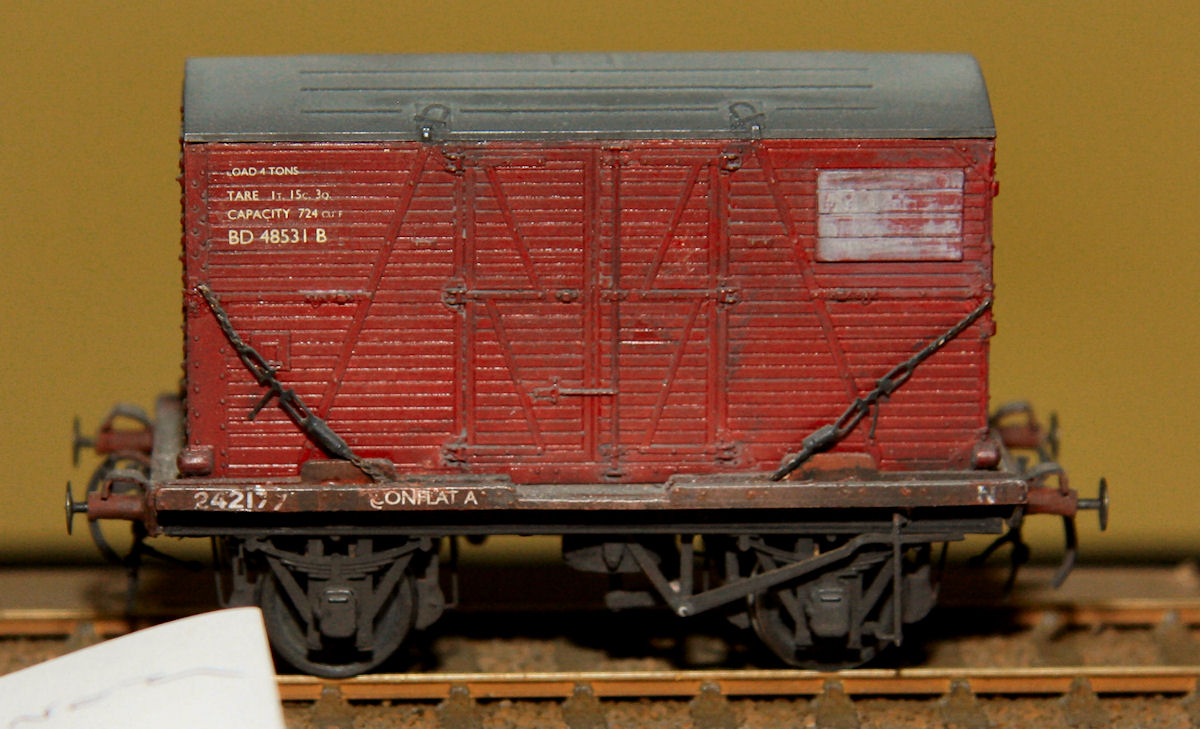 LNER Conflat with BR Brown Container. A Parkside kit with Masokits underframe detail and extra detail.
LNER Conflat with BR Brown Container. A Parkside kit with Masokits underframe detail and extra detail.
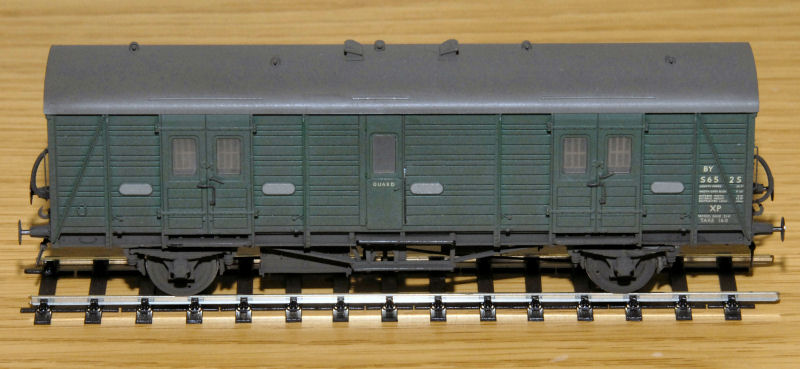 detailed and weathered Parkside Southern van in P4
detailed and weathered Parkside Southern van in P4
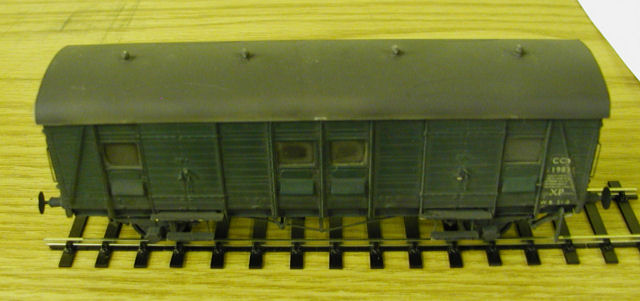 Southern CCT utility van. A Parkside kit with Masokits sprung underframe, with many other extra details including, wire handrails and sprung buffers.
Southern CCT utility van. A Parkside kit with Masokits sprung underframe, with many other extra details including, wire handrails and sprung buffers.
 LNER Conflat with Open Container. A Parkside kit with Masokits underframe detail and extra detail.
LNER Conflat with Open Container. A Parkside kit with Masokits underframe detail and extra detail.
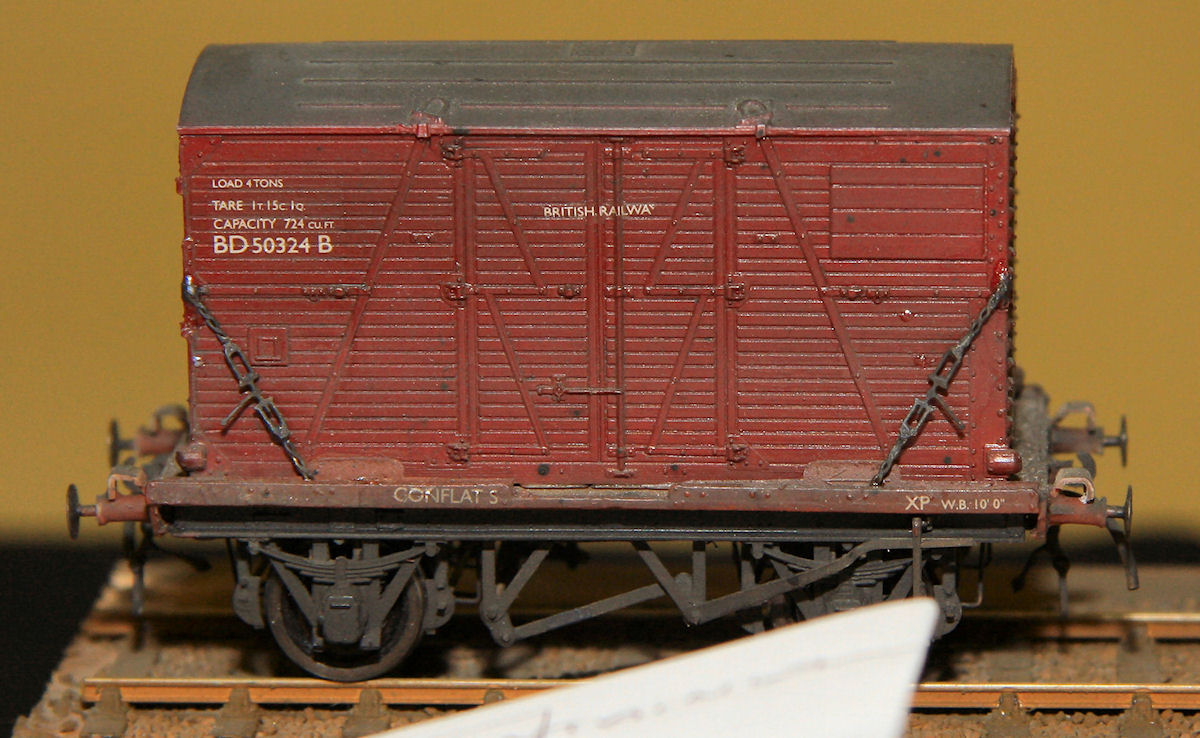 LNER Conflat with BR Container. AParkside kit with Masokits underframe and scratch built detail
LNER Conflat with BR Container. AParkside kit with Masokits underframe and scratch built detail
Ian Gearing
Ian Roll
Richard Turner
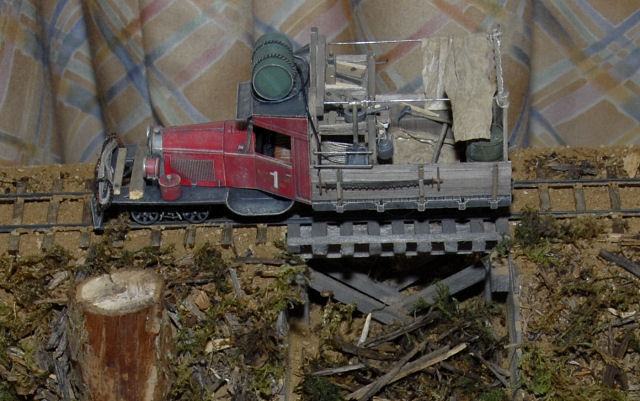 Buick Rail-Truck 1/4 inch Scale. The rail-truck started life as a Bachmann R-T-R model. The rear of the vehicle was stripped and the electronics board and wiring removed so that the new DZ143 chip could be installed in a smaller space under the workshop racking. The truck has working head and tail lights. The workshop is scratch built plywood and bass wood that has been pre stained, built to look crooked and weathered. Detail parts are a combination of scratch built castings from Grant Line and S&D Models, painted and weathered prior to installation. The canvas is standard printer paper that has been crumpled and rolled in the hand to destroy the finish and make it supple which then accepts a wash of paint. The cab and chassis have been re-sprayed and give a liberal grimy wash before dry-brushing.
Buick Rail-Truck 1/4 inch Scale. The rail-truck started life as a Bachmann R-T-R model. The rear of the vehicle was stripped and the electronics board and wiring removed so that the new DZ143 chip could be installed in a smaller space under the workshop racking. The truck has working head and tail lights. The workshop is scratch built plywood and bass wood that has been pre stained, built to look crooked and weathered. Detail parts are a combination of scratch built castings from Grant Line and S&D Models, painted and weathered prior to installation. The canvas is standard printer paper that has been crumpled and rolled in the hand to destroy the finish and make it supple which then accepts a wash of paint. The cab and chassis have been re-sprayed and give a liberal grimy wash before dry-brushing.
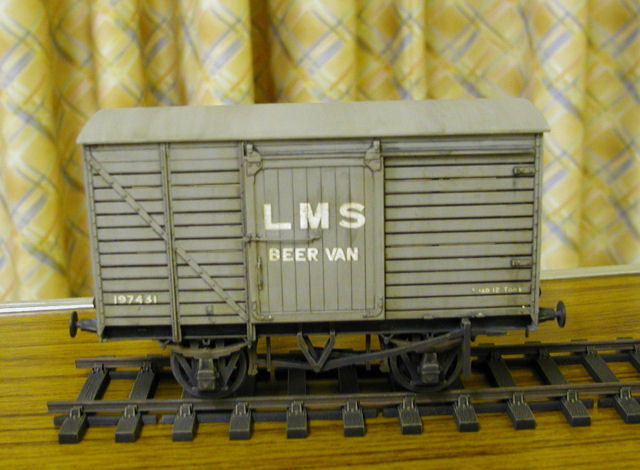 LMS Ventilated Beer Van. This is made from a Parkside plastic kit. Painted using airbrush, weathered using washes and drybrush.
LMS Ventilated Beer Van. This is made from a Parkside plastic kit. Painted using airbrush, weathered using washes and drybrush.
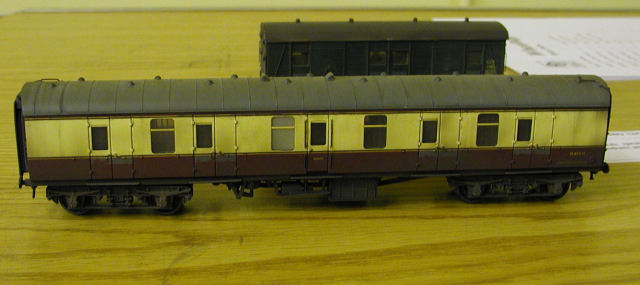 Mark 1 Full Brake. Stripped and detailed cleaned and reapplied as necessary. Repainted and weathered using an airbrush.
Mark 1 Full Brake. Stripped and detailed cleaned and reapplied as necessary. Repainted and weathered using an airbrush.
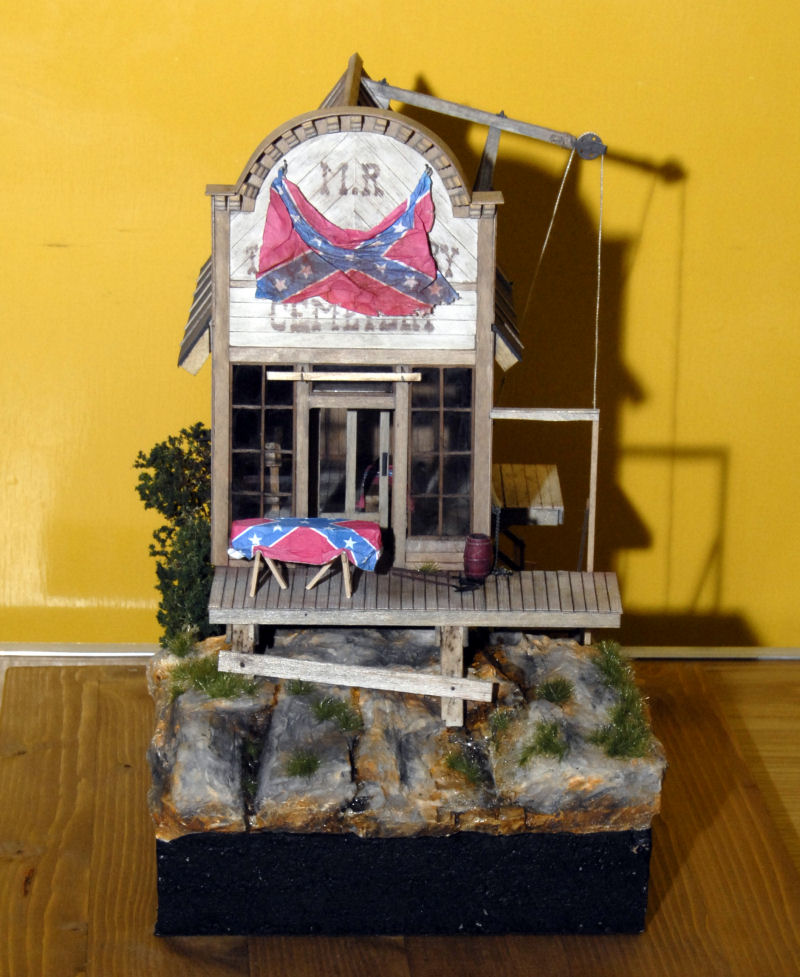 Cemetery Office, scratch built from plywood and bass wood.
Cemetery Office, scratch built from plywood and bass wood.
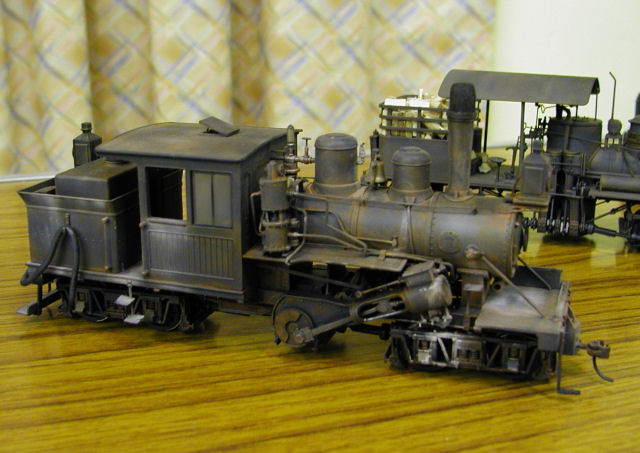 1:48 scale 20 Tonne Climax. A Bachmann Climax stripped and remodelled as seen. Other added details include bake pump, tank and piping. Heavy weathering is applied by airbrush, washes and drybrushing, check out the oil runs on the rear of the tender. Fully fitted with DCC and sound.
1:48 scale 20 Tonne Climax. A Bachmann Climax stripped and remodelled as seen. Other added details include bake pump, tank and piping. Heavy weathering is applied by airbrush, washes and drybrushing, check out the oil runs on the rear of the tender. Fully fitted with DCC and sound.
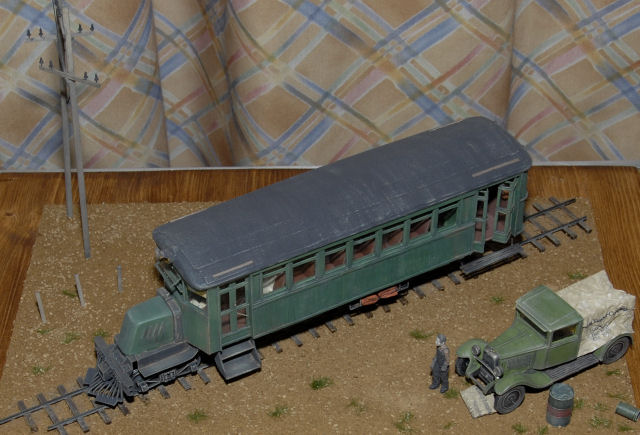 Mack Rail-Bus 1/4 inch Scale. The Mack Rail-Bus is scratch built from Plasticard, using a base of 5thou sheet and layered up with sections of Evergreen styrene strip. The undercarriage has been made from sections of tube and sheeting built up as smaller components, such as the differential and suspension, which has all been combined to complete the under carriage.
Constructed of 6 components, the sides, front and rear, floor-plan with undercarriage and roof, the overall finish is that of a run down well used rail-bus. The rear wheels are custom made by Gibson, all wheels providing pickup for a DSD90 Sound Chip located on the floor of the bus. The finish is mid-green enamel sprayed prior to installing the glazing, with a dry-brush of light stone to finish. Details include seating from Grant Line.
Mack Rail-Bus 1/4 inch Scale. The Mack Rail-Bus is scratch built from Plasticard, using a base of 5thou sheet and layered up with sections of Evergreen styrene strip. The undercarriage has been made from sections of tube and sheeting built up as smaller components, such as the differential and suspension, which has all been combined to complete the under carriage.
Constructed of 6 components, the sides, front and rear, floor-plan with undercarriage and roof, the overall finish is that of a run down well used rail-bus. The rear wheels are custom made by Gibson, all wheels providing pickup for a DSD90 Sound Chip located on the floor of the bus. The finish is mid-green enamel sprayed prior to installing the glazing, with a dry-brush of light stone to finish. Details include seating from Grant Line.
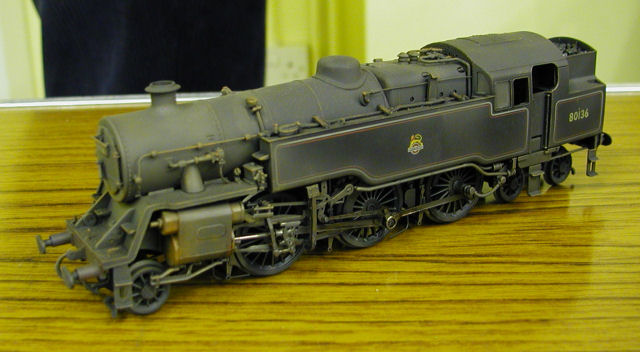 Standard 4 Tank, which started life as a Bachmann model. Stripped and detail re-applied as required. Standard fittings such as lift rings, replacement wheels, coal rack and irons have been added. Heavy weathering has been applied by airbrush and drybrushing.
Standard 4 Tank, which started life as a Bachmann model. Stripped and detail re-applied as required. Standard fittings such as lift rings, replacement wheels, coal rack and irons have been added. Heavy weathering has been applied by airbrush and drybrushing.
Kevin Wood
Max Brayne
David Pitcher
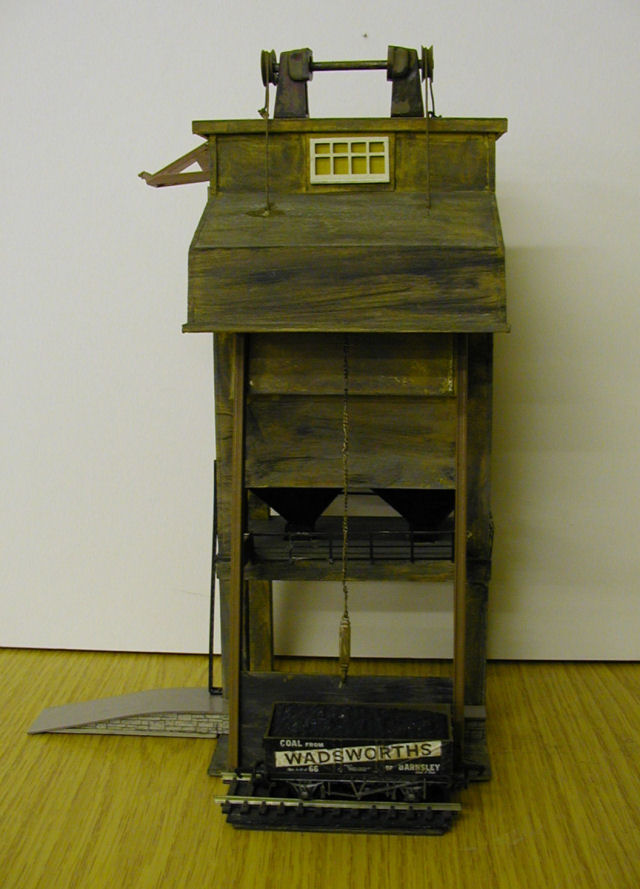 Scratch built coaling tower, this has been based on a photo of the LNER tower at Carnforth Lancashire.
Scratch built coaling tower, this has been based on a photo of the LNER tower at Carnforth Lancashire.
Ted Smale
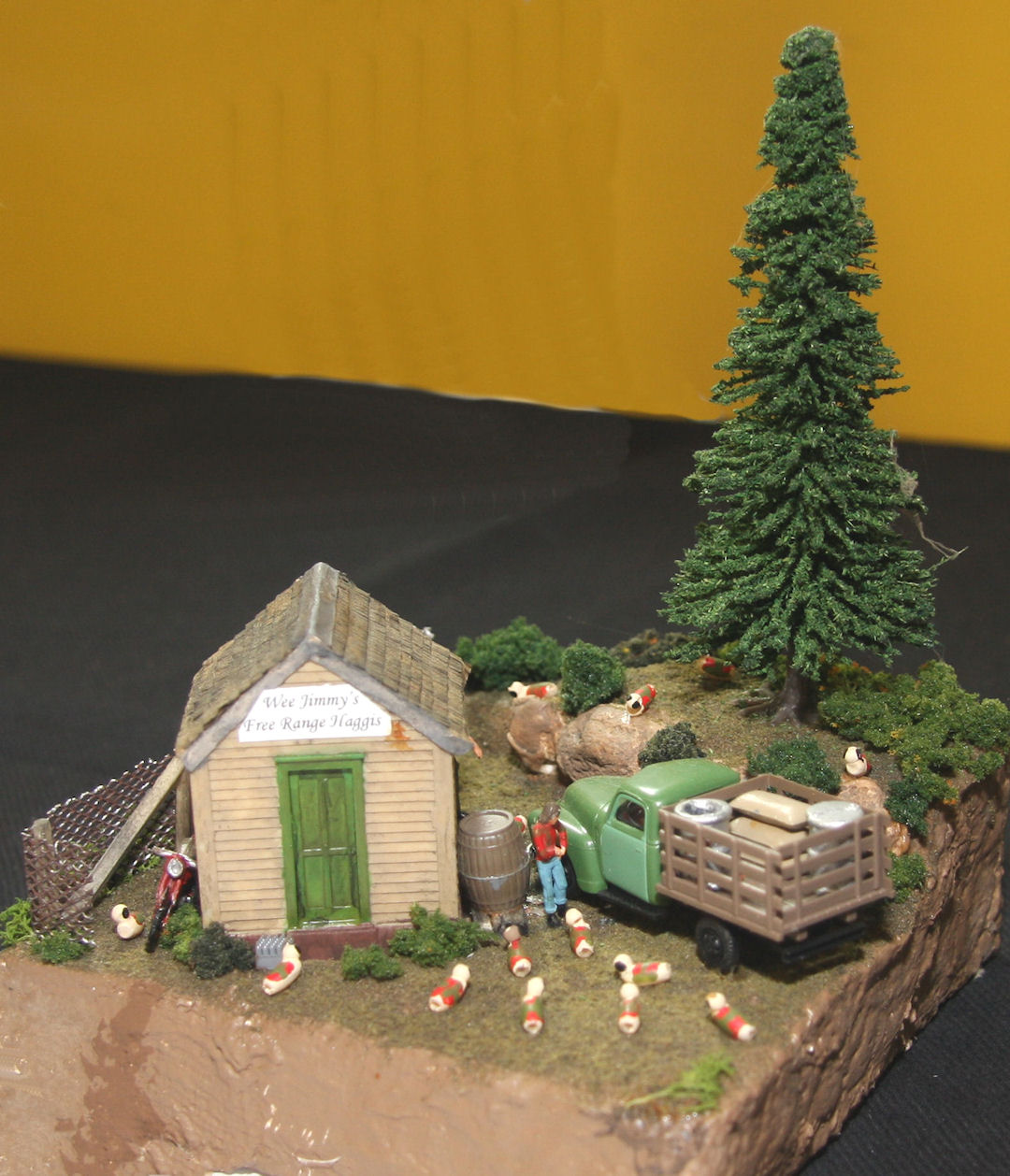 Wee Jimmies Free Range Haggis Hut. A small diorama/industry built from a resin cast hut, with Grandt Line window casting added, roof is made from individual strips of paper 'shingles' that are glued in place. The motorcycle is a white metal kit, the truck is a HO scale stake bed. Rock castings and Woodland Scenics materials used for the terrain, wire mesh for fencing. Figures are home painted Prieser with various detail parts added to make the scene. The Haggis are made from two sizes of beads, painted in the McCulloch tartan, they are lowland Haggis - both sets of legs the same (short!) length. The Haggis are then caught, killed and dressed before being shipped out by Ice Reefer car from a spur (siding) on his layout.
Wee Jimmies Free Range Haggis Hut. A small diorama/industry built from a resin cast hut, with Grandt Line window casting added, roof is made from individual strips of paper 'shingles' that are glued in place. The motorcycle is a white metal kit, the truck is a HO scale stake bed. Rock castings and Woodland Scenics materials used for the terrain, wire mesh for fencing. Figures are home painted Prieser with various detail parts added to make the scene. The Haggis are made from two sizes of beads, painted in the McCulloch tartan, they are lowland Haggis - both sets of legs the same (short!) length. The Haggis are then caught, killed and dressed before being shipped out by Ice Reefer car from a spur (siding) on his layout.
Pete Miller
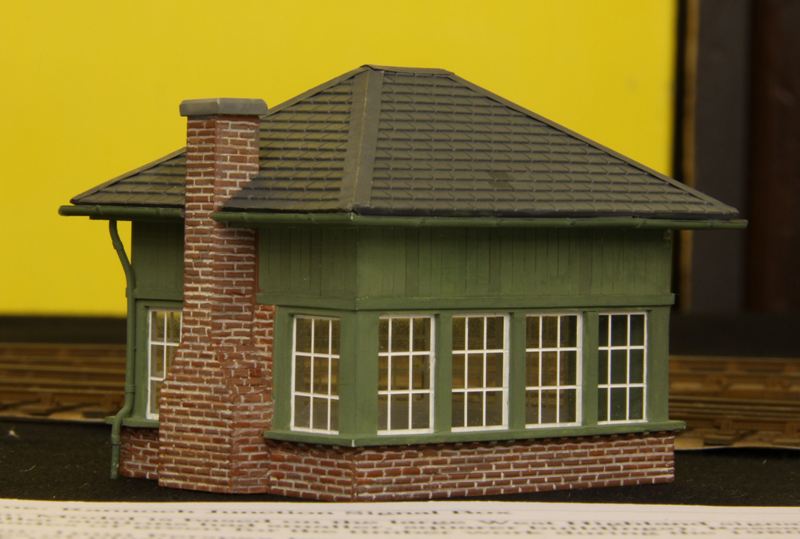 Rannoch Junction Signal Box. This model is based on the large West Highland signal box at Crianlarich (other smaller stations had smaller, squarer buildings). Research shows up at least 4 different shades of green for the timber work during the 1980s alone!
Rannoch Junction Signal Box. This model is based on the large West Highland signal box at Crianlarich (other smaller stations had smaller, squarer buildings). Research shows up at least 4 different shades of green for the timber work during the 1980s alone!
Construction: 1mm Perspex box with scored windows, filled with paint, clad with various types of plasticard including Slaters and Wills 'slate' for the roof. Timberwork is scored 1mm sheet and evergreen strip. Lead flashing is strips of Tesco value copier paper. Paint is various mixes of Humbrol enamel.
To do: 1x chimney pot, lever frame and a coat of paint for the inside. Once these are done the flashing around the chimney needs to be finished. A station nameboard, then a bit more weathering…
Adrian Harford
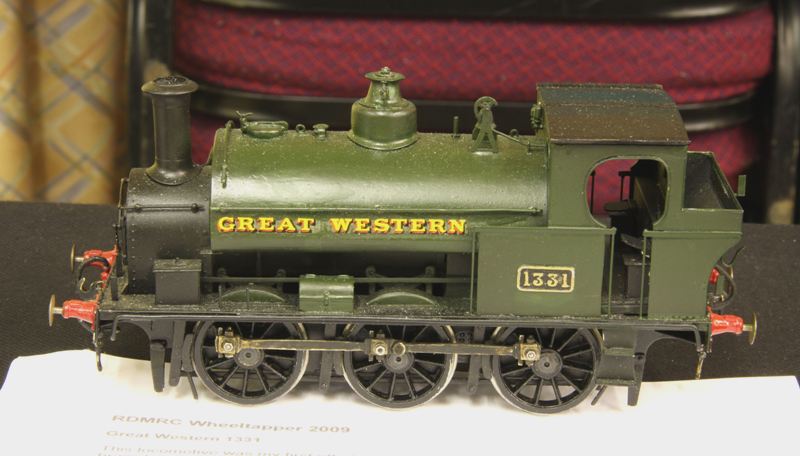 Great Western 1331. This locomotive was Adrian’s first effort at loco-building and was his introduction to etched brass kits (and a few other things as well). The kit is by Pete Stamper (Agenoria) and represents an absorbed engine (alone in its class) which is built and painted to represent its period of service (roughly 1930 -1935) on the Weymouth Harbour Tramway. Adrian had to rebuild the chassis (starting with new frets from Agenoria) before he could get reasonable running characteristics out of it. The kit was advertised as suitable for beginners, but it wasn’t until he successfully completed the Connoisseur starter loco kit by Jim McGeown that he began to realise how some things should have been done – and some not done (using plunger pick-ups and attempting compensation). He also switched from using ZTC DCC decoders (lots of them) to a Digitrax decoder. The loco shows real signs of being fit for purpose. To complete it he needs to adorn it with coal, tools and some manpower and find some way of fitting the Digitrax sound chip he bought at Risex!
Great Western 1331. This locomotive was Adrian’s first effort at loco-building and was his introduction to etched brass kits (and a few other things as well). The kit is by Pete Stamper (Agenoria) and represents an absorbed engine (alone in its class) which is built and painted to represent its period of service (roughly 1930 -1935) on the Weymouth Harbour Tramway. Adrian had to rebuild the chassis (starting with new frets from Agenoria) before he could get reasonable running characteristics out of it. The kit was advertised as suitable for beginners, but it wasn’t until he successfully completed the Connoisseur starter loco kit by Jim McGeown that he began to realise how some things should have been done – and some not done (using plunger pick-ups and attempting compensation). He also switched from using ZTC DCC decoders (lots of them) to a Digitrax decoder. The loco shows real signs of being fit for purpose. To complete it he needs to adorn it with coal, tools and some manpower and find some way of fitting the Digitrax sound chip he bought at Risex!

